This was undeniably the treat of our whole travelling trip! We had saved up for it separately from over-transferring money for bills into a shared account when Hats and I were living together before our trip. But even with the money we saved up, there was still not really enough in reality…
There are two different ways to see the Galapagos. The first option is to book on to a cruise of the islands – the plus side of this is that you can get to parts of the islands (and whole islands) that are otherwise inaccessible. But, as you probably guessed it, cruises are crazy expensive (none more so than in the Galapagos). The second option is to go it alone, basing yourselves on inhabited parts of islands and doing day trips from there. There are a number of walking trails and accessible beaches from each of the three major towns on the Galapagos and lots of tourists agencies that can book you on to day trips to venture a bit further afield.
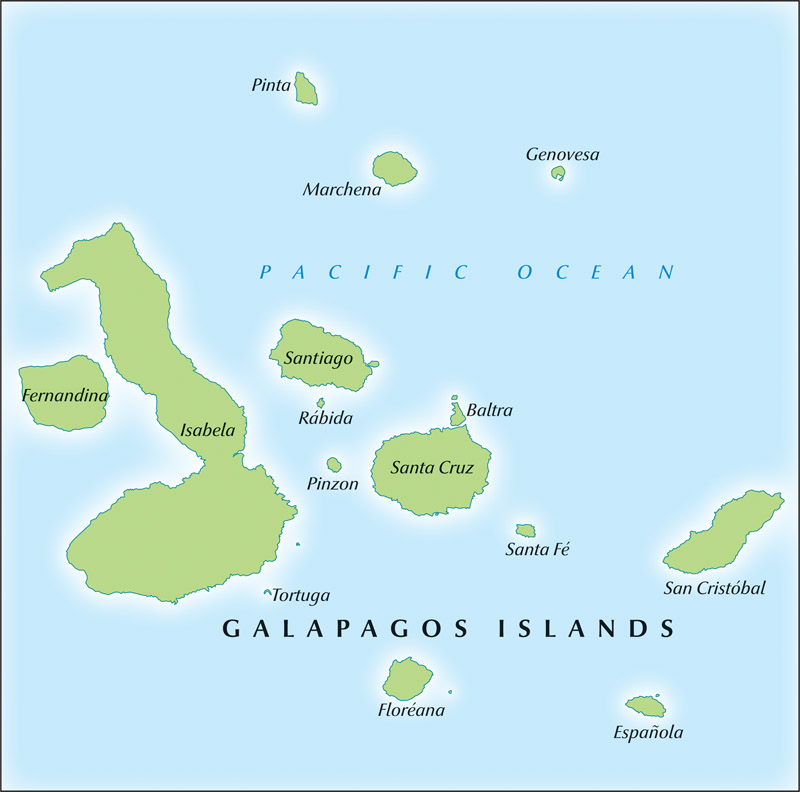
A map of the Galapagos Islands
We had about 13 days maximum available to visit the islands in our itinerary; so with this flexibility, my preferred option was to arrive there and see if we could get booked on to a last-minute (and therefore less-expensive) cruise, and do day trips while we waited. However, Hats didn’t agree and thought due to this being peak season we would struggle to get any last-minute cruise, let alone one that we would want to do (different boats visit different islands). We spent weeks leading up to our visit deliberating, but in the end it was me who blinked first – and we decided to settle on a 5 day cruise booked 2 weeks in advance online with the Galaven boat. We got it on a 2 for 1 deal, but even this was really expensive (about £800 each) – which puts in to perspective how expensive the islands can be for people booking a holiday here in advance. We decided there was plenty to do on the islands, so we would spend about another 7 days based on the islands to explore ourselves. It worked out very well! There are some tips on how best to do the islands at the bottom of this post, now that we know how 🙂
We flew from Guayaquil (South Ecuador) to Baltra airport which is close to the town of Puerto Ayora on Santa Cruz island (the hub of tourist activity and the biggest town on the Galapagos). This was where we we planned to spend our first 5 days before the cruise. On our first day we explored the Puerto Ayora town itself and visited the Charles Darwin Research Station. Unfortunately a fair bit of it was closed/inaccessible, but we got the jist of things and enjoyed the walk to/from the station. The next day we ventured further afield to Tortuga Bay, about a 1 hour walk from town, which is a pristine white beach where we came up close to marine iguanas for first time! Little did we know that we would not stop seeing them for the next 12 days… We also rented out snorkelling gear but unfortunately didn’t get to see too much apart from a few fish near shore.
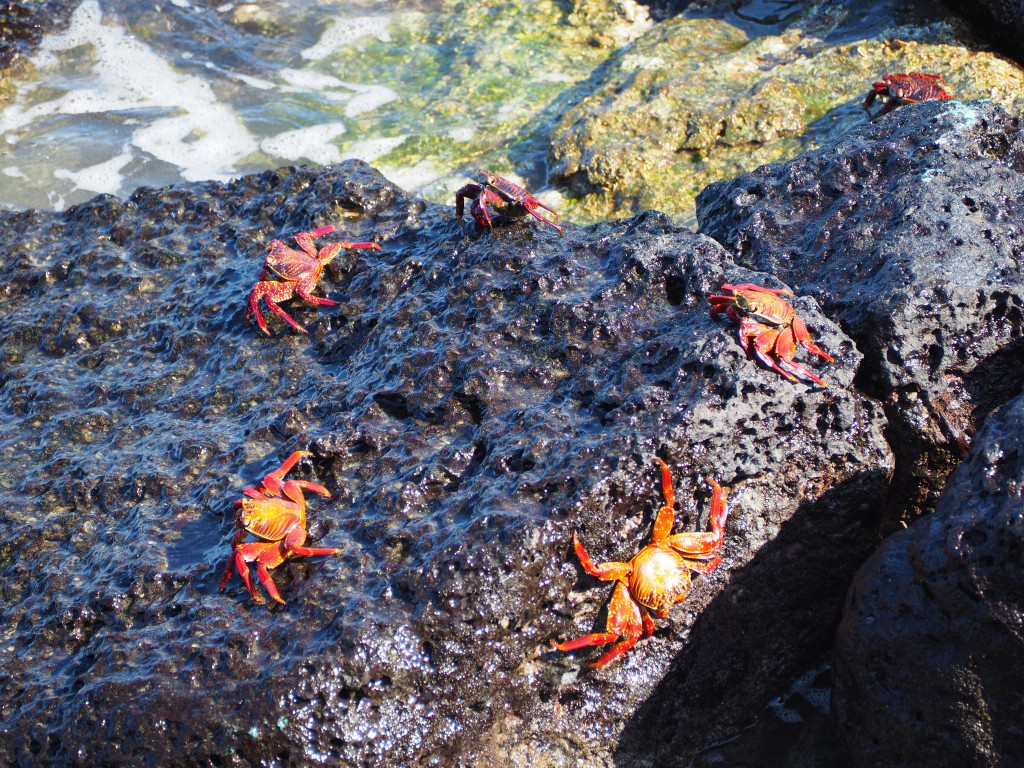
As soon as we arrived on th islands there were animals to see, for example here are lots of Sally Lightfoot crabs by the port of Puerto Ayora
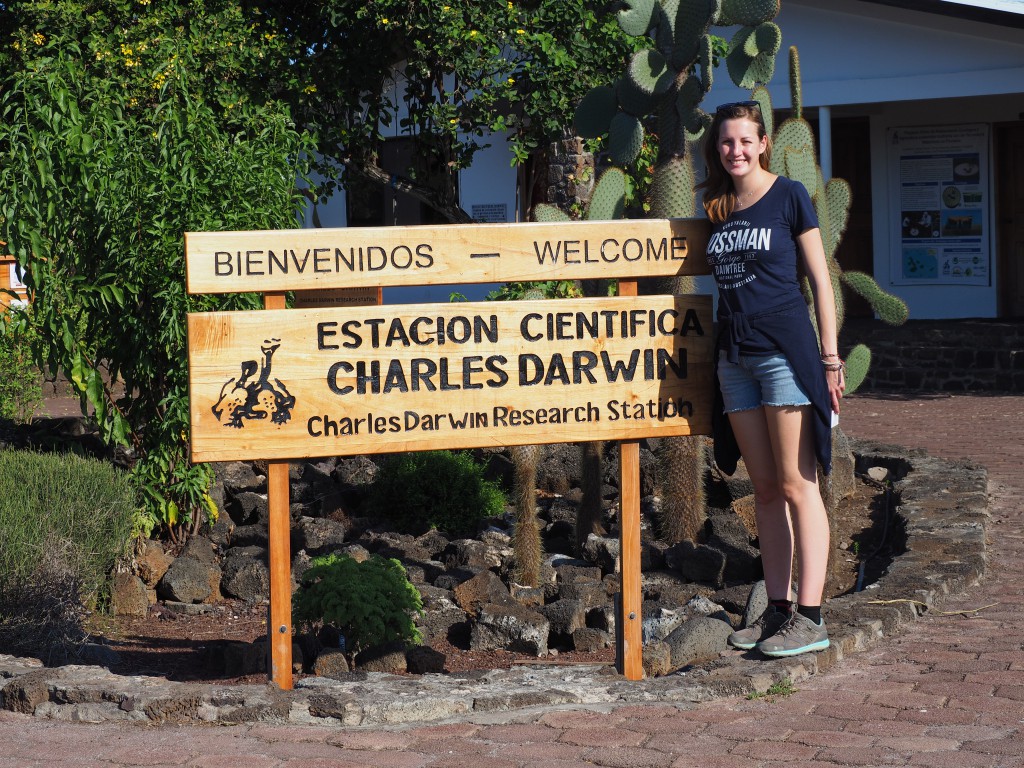
Hats at the Charles Darwin Research Station
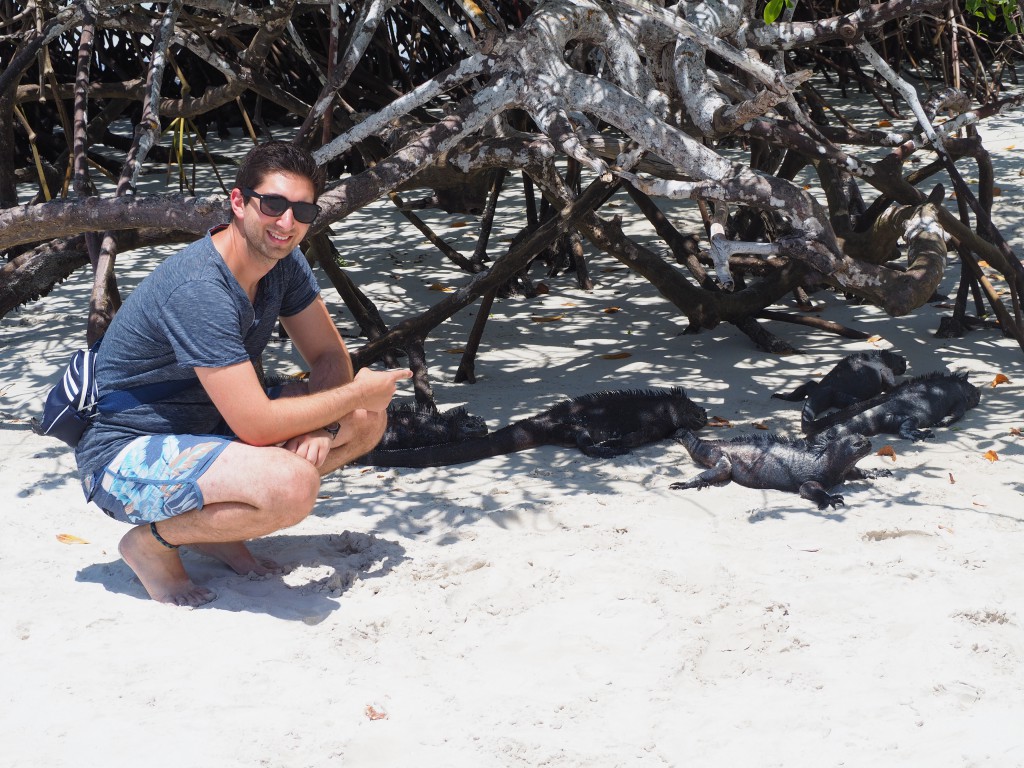
Our first spotting of marine iguanas lazing about at Tortuga Bay
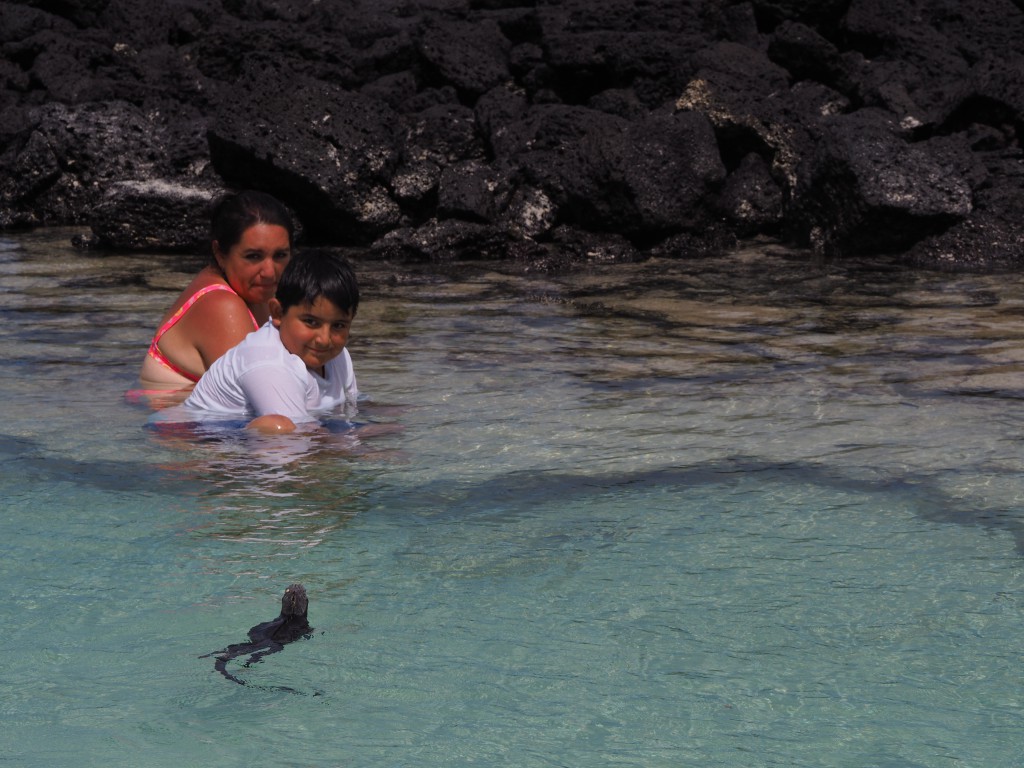
A marine iguana snaking in the water towards two Ecuadorians
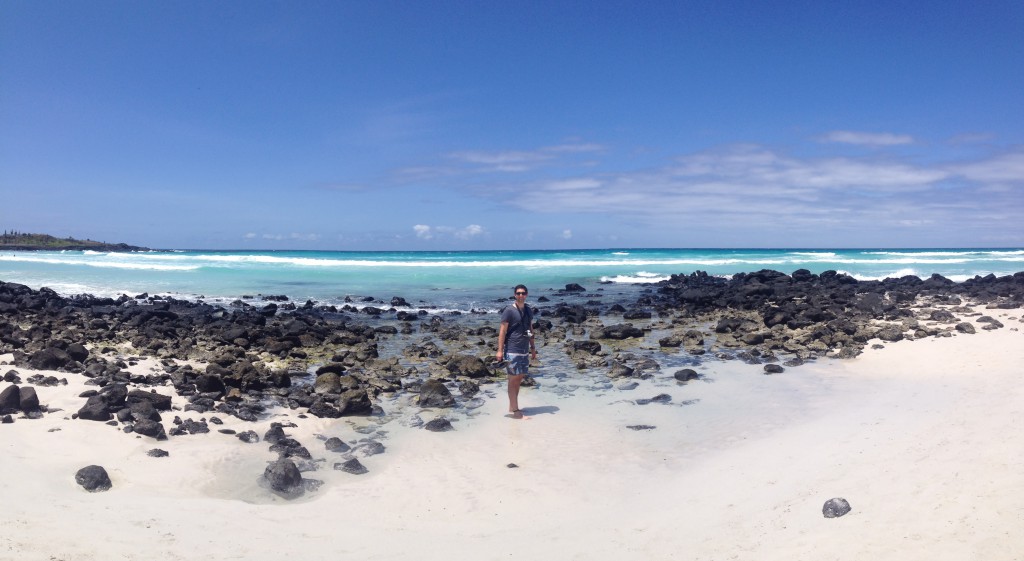
The beach near Tortuga Bay – it was paradise!
After visiting a few agencies in town, we also got a good idea of the day tours available and the prices to expect (around US$100). After some great advice from one agency, we decided to book a tour to Los Tunneles (lava tunnels) on another island Isabela, but not a day tour that would bring us back to Santa Cruz as it would be impossible to do get there, do this tour and come back in a day. Instead to do this tour, we’d have to stay one night in the inhabited port city of Puerto Villamil on Isabela, which we were more than happy to do as it let us explore another island properly 🙂
We were warned about the boat trips between the inhabited islands so we bought sea-sickness tablets in advance, and boy we’re glad we did. The small speedboat of about 14 people leapt over the rough waves for 2 hours to Puerto Villamil, which would have definitely make us puke had we not been on pills. We arrived to be greeted by swimming penguins around the dock, and then checked in to our accommodation before heading out on our tour of Los Tunneles. We were on a tour with all Ecuadorians, which although was lovely to see mainland-nationals exploring their own beautiful islands, it meant that 70% of the tour was in Spanish. The guide did repeat important things in English, but we missed out on lots of supplementary information and questions & answers. Regardless of this though we had an amazing time! We first explored the lava tunnels by foot, and then jumped in the water a little further away in a great snorkelling spot where we snorkelled with loads of giant tortoises! We also came across a big shark cave with about 4 white-tip reef sharks swimming around, and one of them swam straight past me!
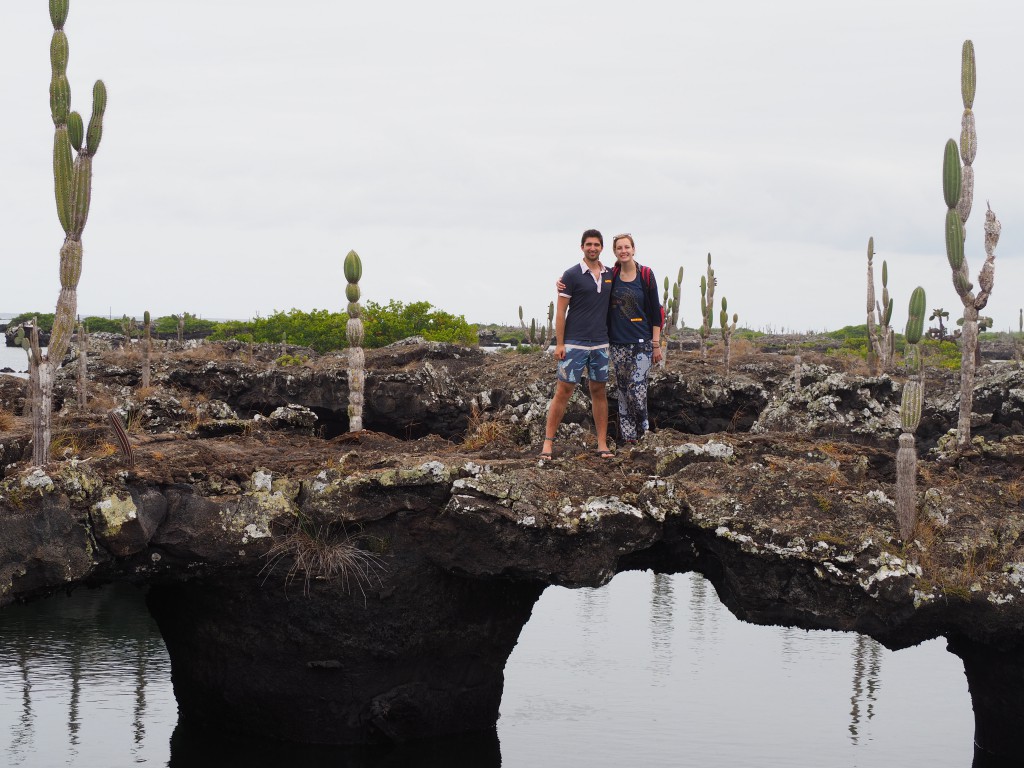
Me and Hats at Los Tunneles (the lava tunnels) off Isabela island
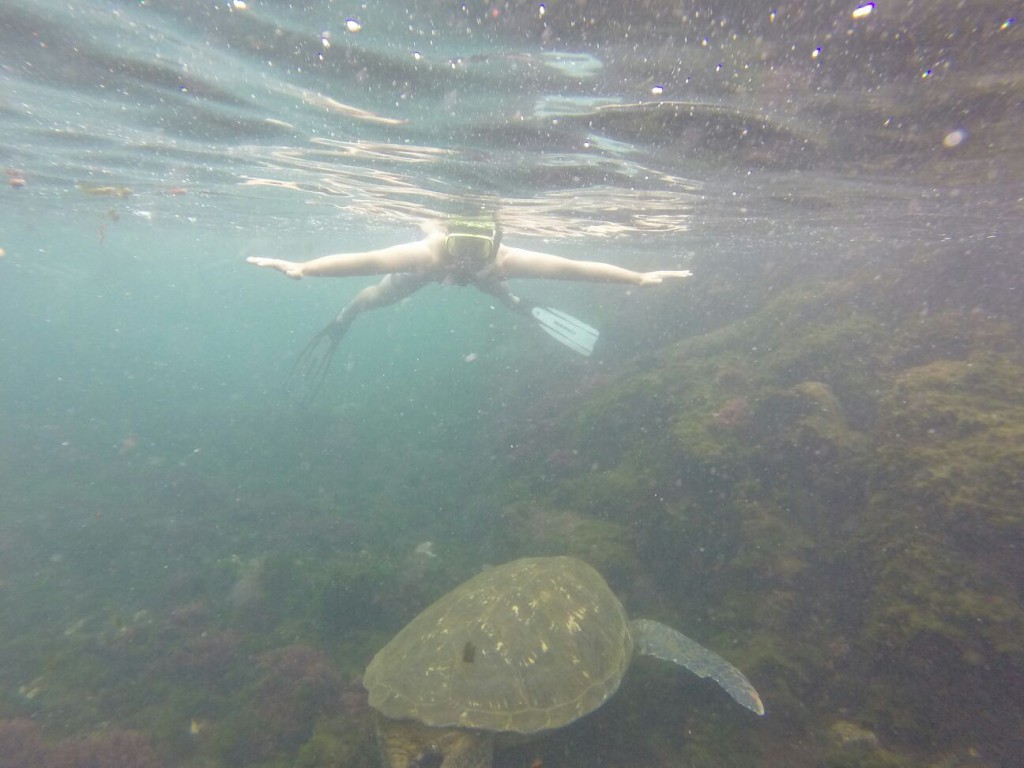
The sea turtles at Los Tunneles were HUGE, much bigger than the ones we saw in Australia
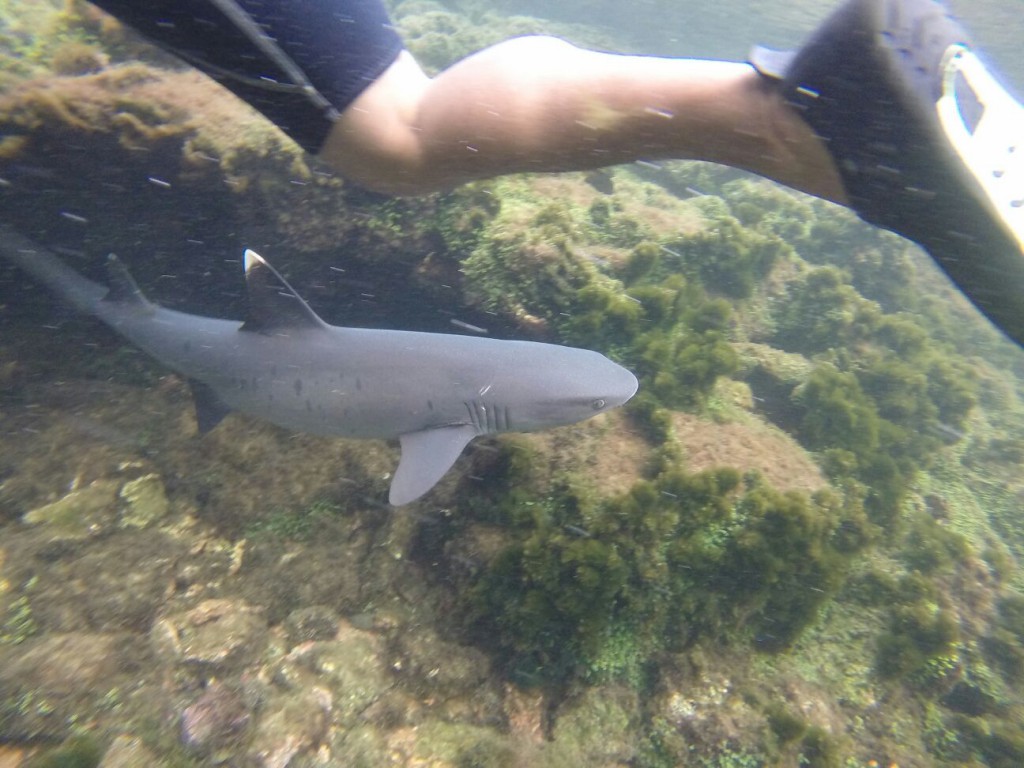
A white-tip reef shark near Los Tunneles – thankfully they’re not interested in human limbs
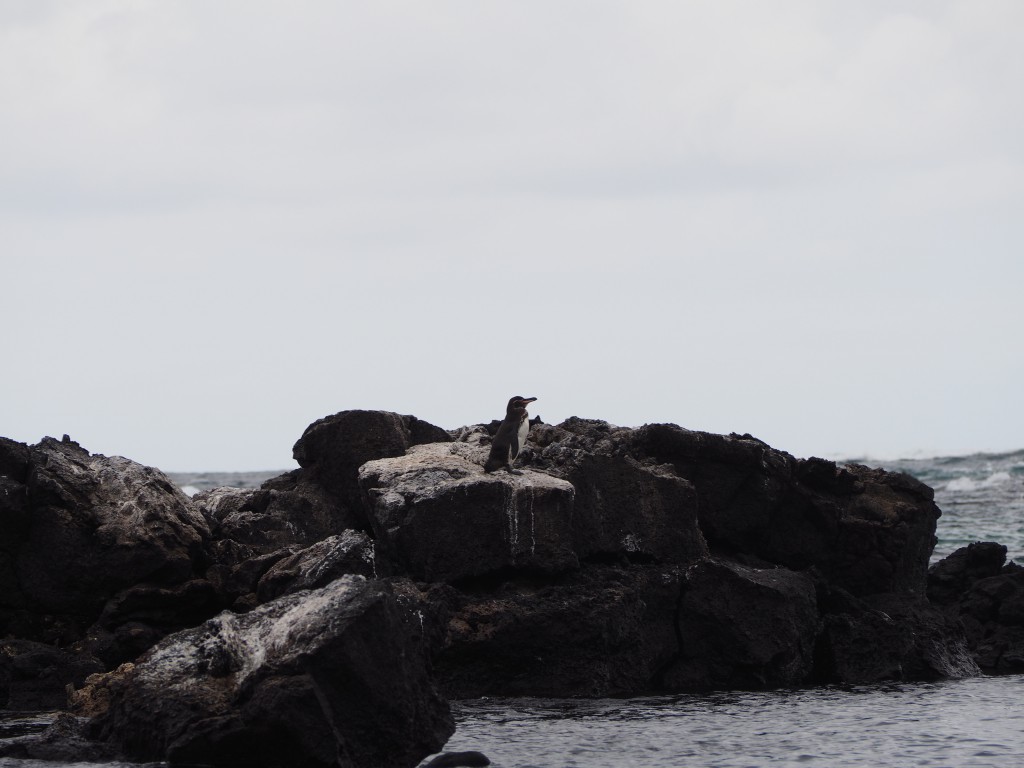
Penguin spotting on the boat back to Puerto Villamil
The next day we had time to explore this brand new island for ourselves a little bit, heading to Poza Puerta del Jeli & Poza Baltazar – two lakes next to each other known for flamingos! We saw about 10 of them – they were so pink and slurping away in the water (we’d never heard them do this before, it was like a vacuum cleaner). Then we went to a snorkelling spot called Concha y Perla, and soon after I got in the water, I spotted a penguin and swam behind it for a good 2 minutes before realising he was a bit too speedy for me. I also got to swim with a marine iguana snaking through the water. After all of this wildlife spotting, we then sat on the beach near the port, to see if we could catch up with the penguins which loved this area. At one point I got to swim briefly with 3 of them and got some great footage of one speeding right by me. Hat went in separately and also had a close penguin encounter, although they were all a little shy with humans. Then we got back in a small speedboat back to Santa Cruz island for one more day exploring the island before our cruise. The highlight of that day was certainly watching the action around a fish market – actually one woman cutting up fish- who was being eagerly watched by a pelican and a sea lion.
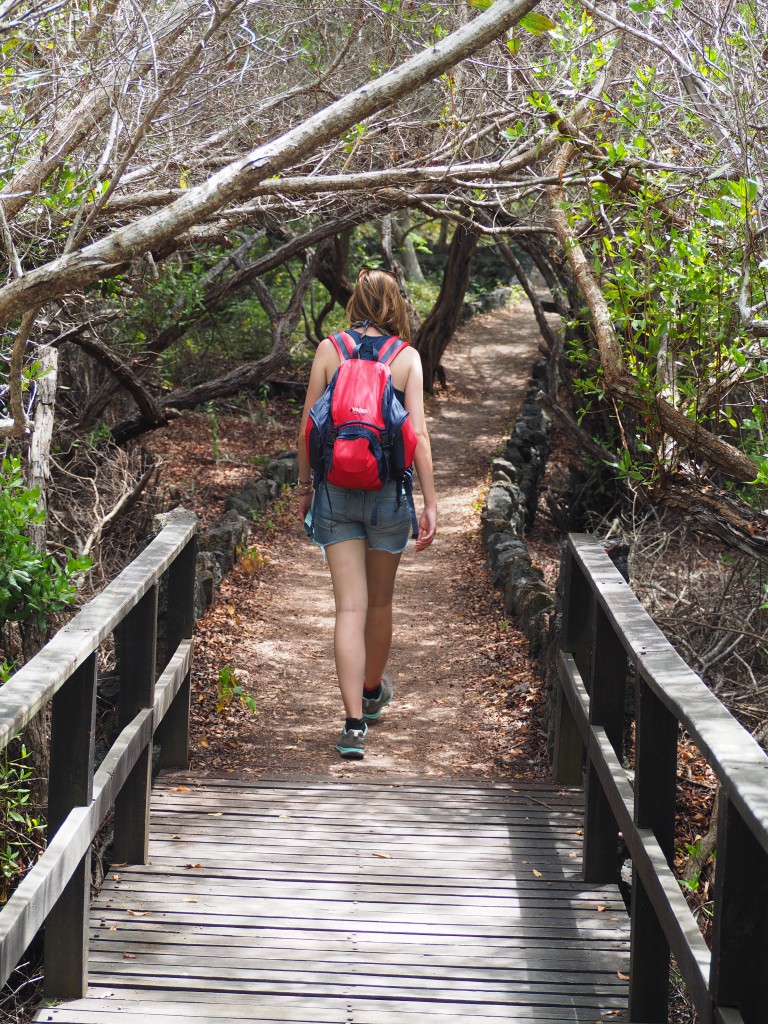
We really enjoyed exploring the walking trails by ourselves – they weren’t touristy at all and always had animals to spot
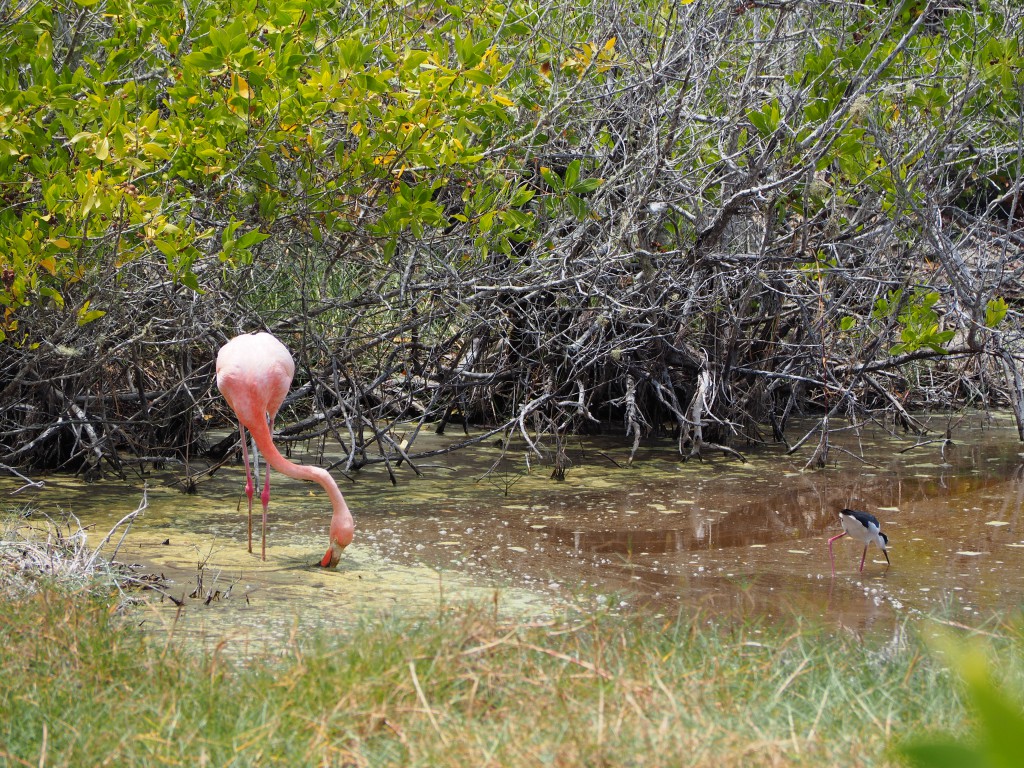
A flamingo slurping away in the water at Poza Baltazar
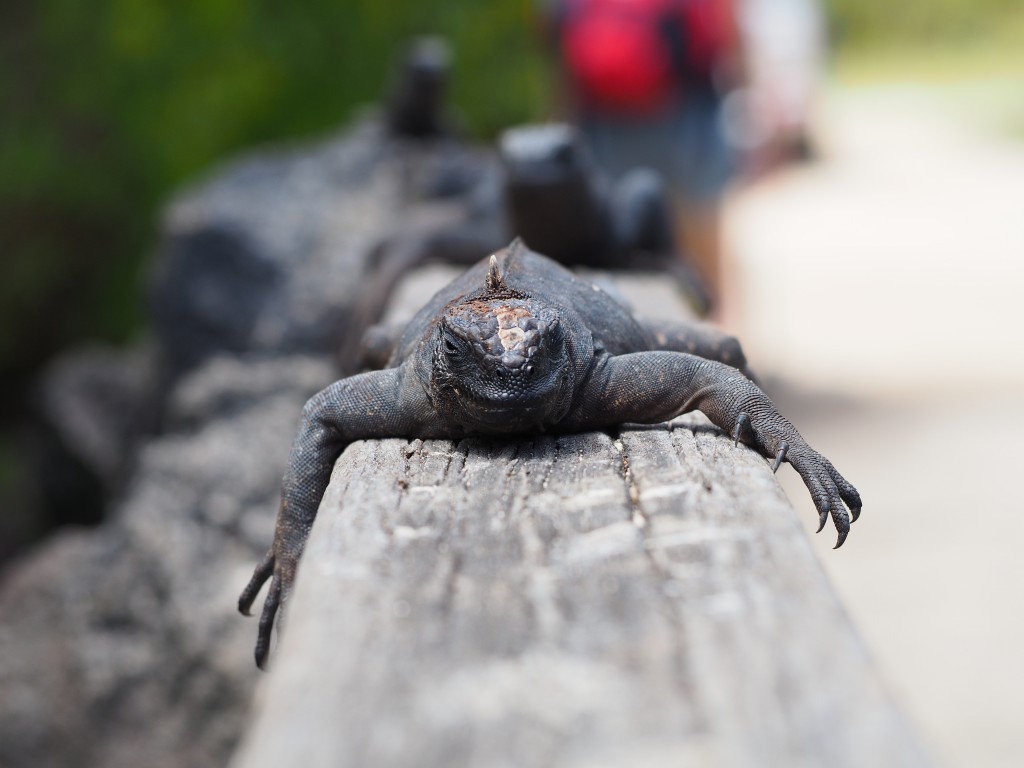
This bridge was full of lazy marine iguanas, one seen here spread out on the hand rail
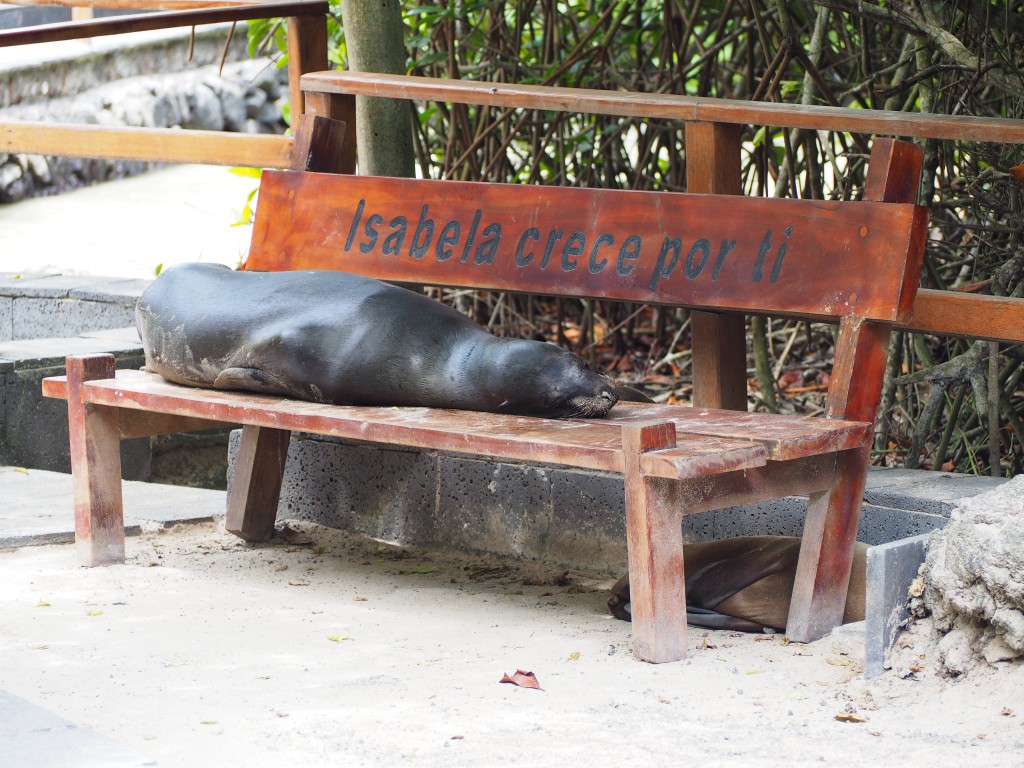
Sea lions especially loved sleeping on benches
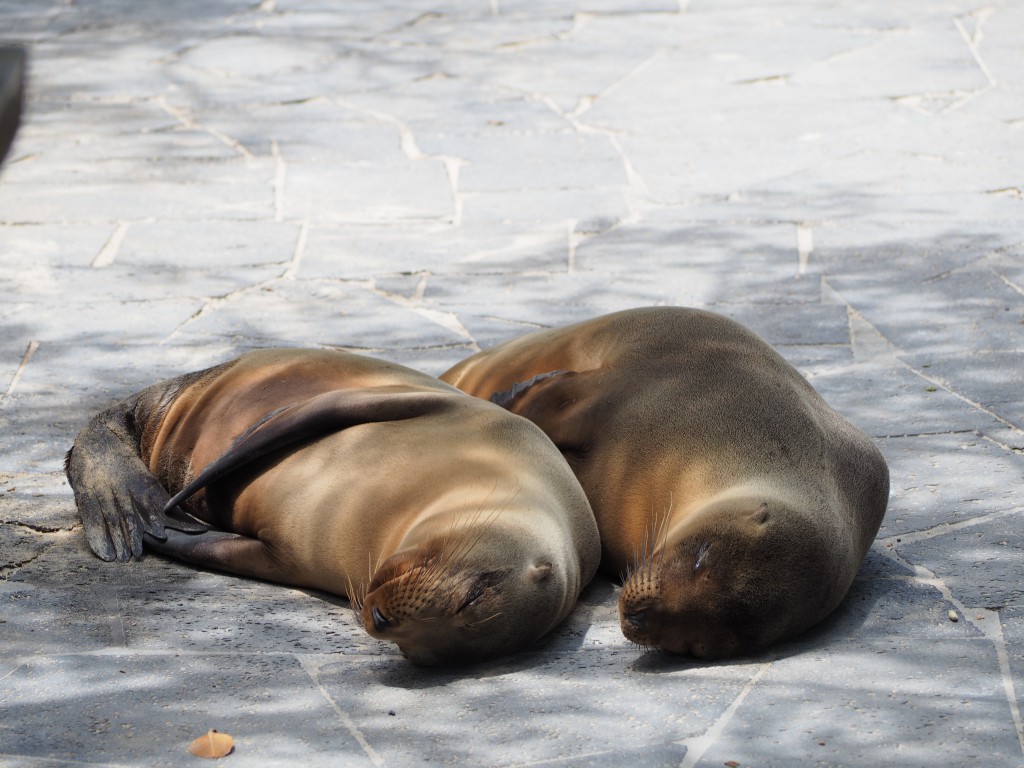
Spooning sea lions
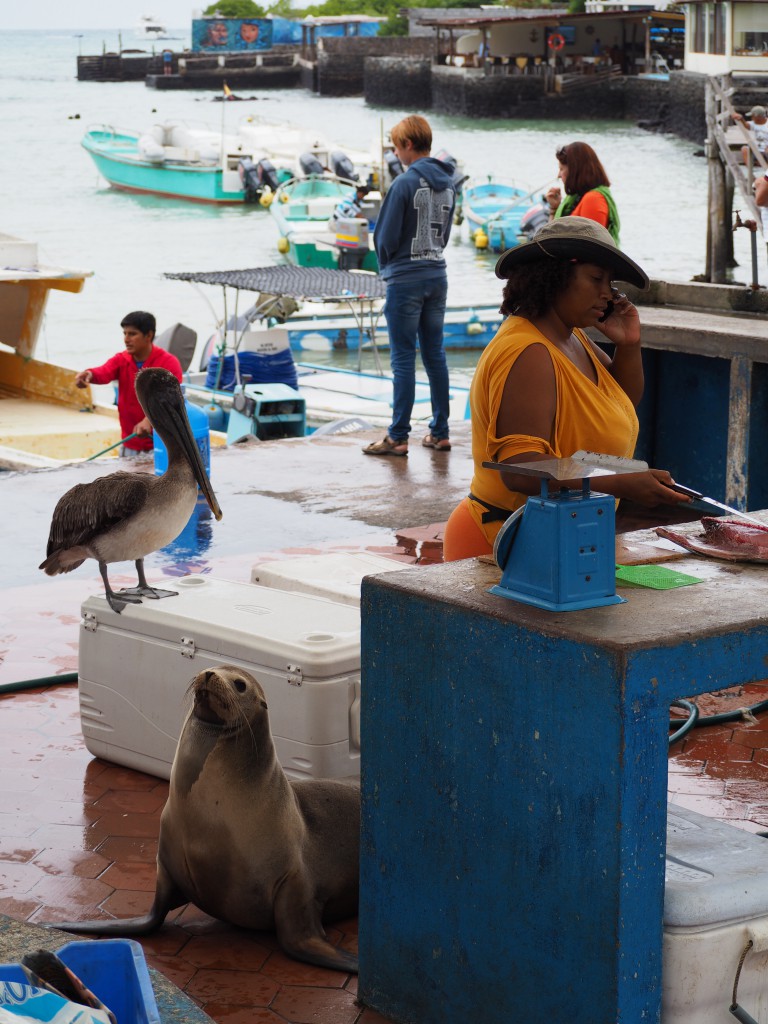
A pelican and a sea lion eagerly wait for a chance to grab the fish at the fish market
After 5 days of doing things our own way, we boarded the Galavan boat for a further 5 days on a short cruise which took us from Santa Cruz island, via Espanola and Floreana islands, to San Cristobal island. We chose the Galaven because of its itinerary and cost when we booked it (it wasn’t a budget boat, but it was priced like other budgets ones when we were booking 2 weeks in advance). Its itinerary meant we weren’t doing too many things we could have done ourselves – i.e. in day trips from the inhabited bits. After a short time on board to meet our fellow passengers and have lunch, we alighted again back to port to visit El Chato Tortoise Reserve, which had lots of giant tortoises in the wild – we didn’t have to walk far to see them from the reserve headquarters – they were everywhere! They were the most amusing animals, merrily stuffing their faces with grass.
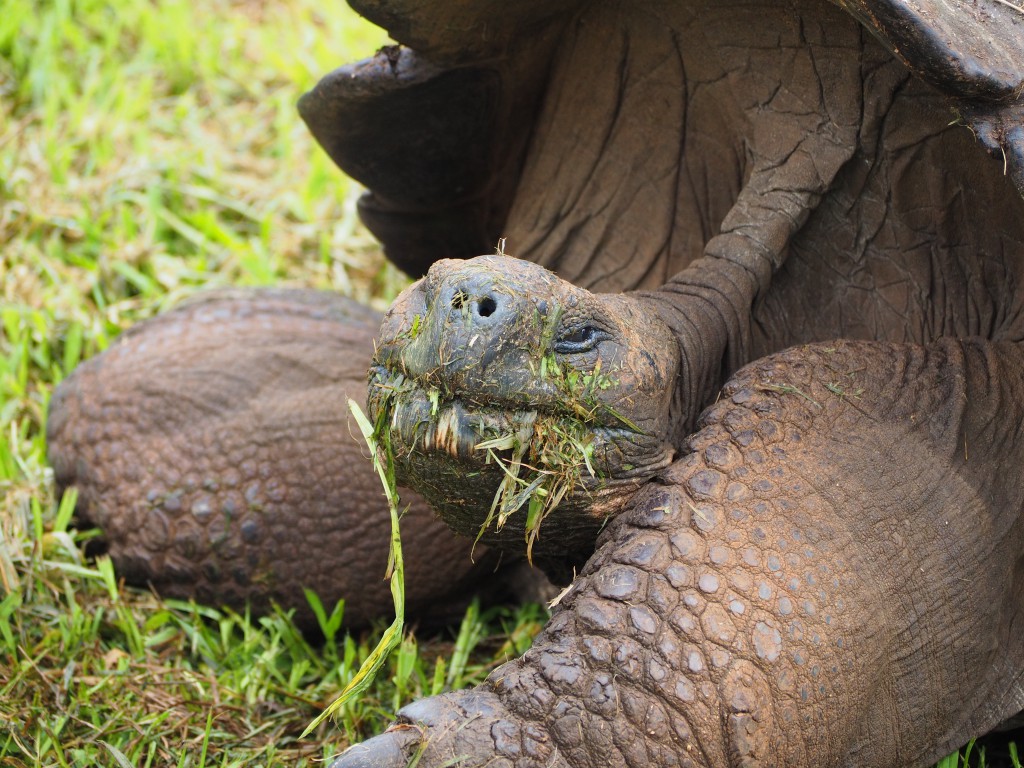
A greedy Galapagos giant tortoise unashamedly stuffing his face
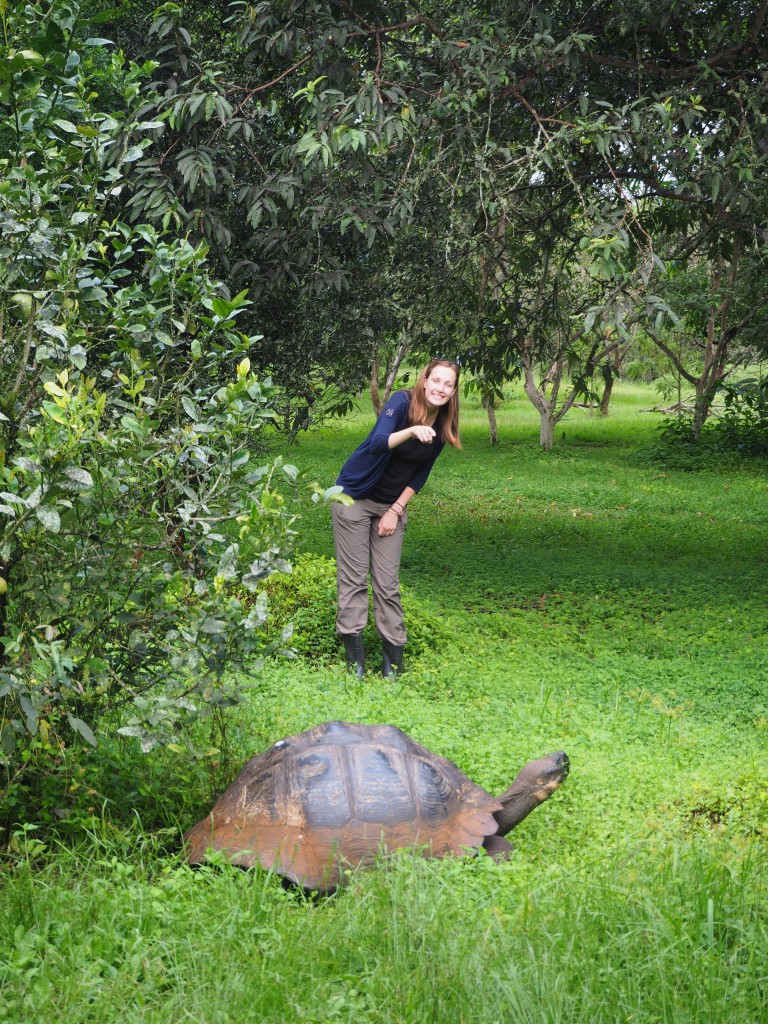
Tortoise spotting
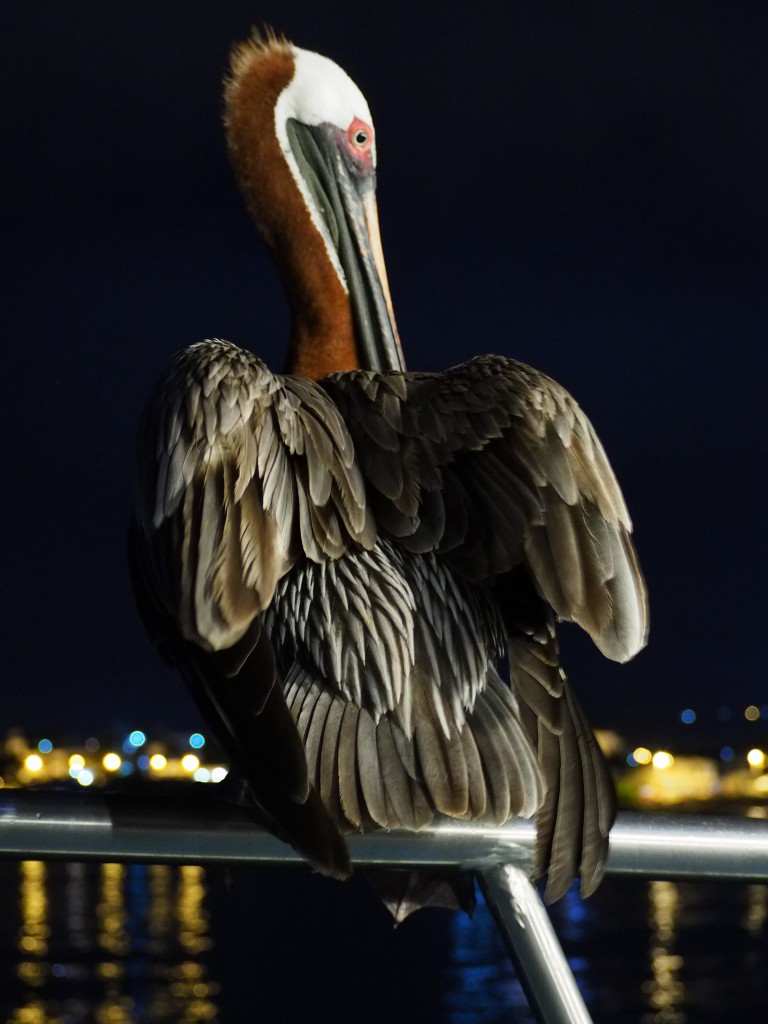
We spent our first evening on the boat chilling out with this big beautiful pelican who decided to perch on the railings of the deck
The next day, after sailing overnight, we woke up on the north of Santa Cruz island, which was an uninhabited part of the island. Our first stop of the day was Dragon Hill, known for land iguanas. Although we’d seen a lot of marine iguanas before this point, these land iguanas were completely different – quite reclusive and amazing striking colours (the males especially). In the afternoon, we went to Bachas Beach famous for sea turtles nesting but we unfortunately only saw the mounds of sand that probably had eggs buried underneath. We went snorkelling here (it was a little choppy so not the best conditions) and also off the side of the boat where we saw an eagle ray among other things. In the evening, straight after dinner, the boat set off on a rocky journey towards Floreana island. I really needed the sea sickness tablets; I took them a bit too late and was oh-so-nearly sick twice before they took effect.
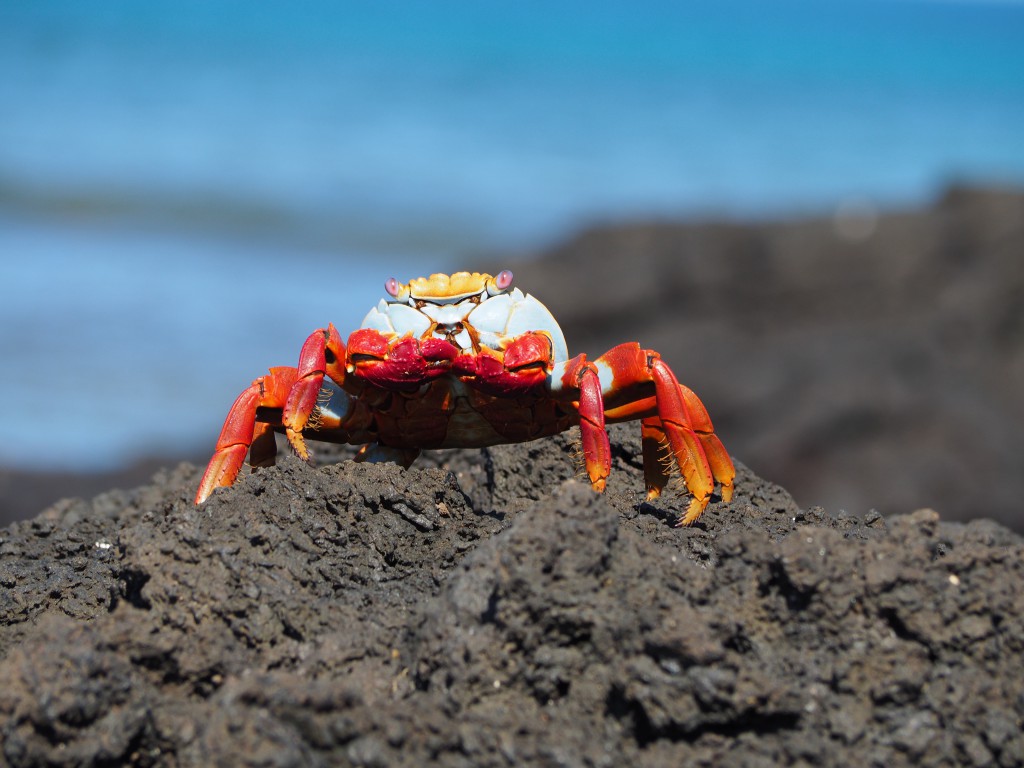
A colourful Sally Lightfoot crab up close at Dragon Hill
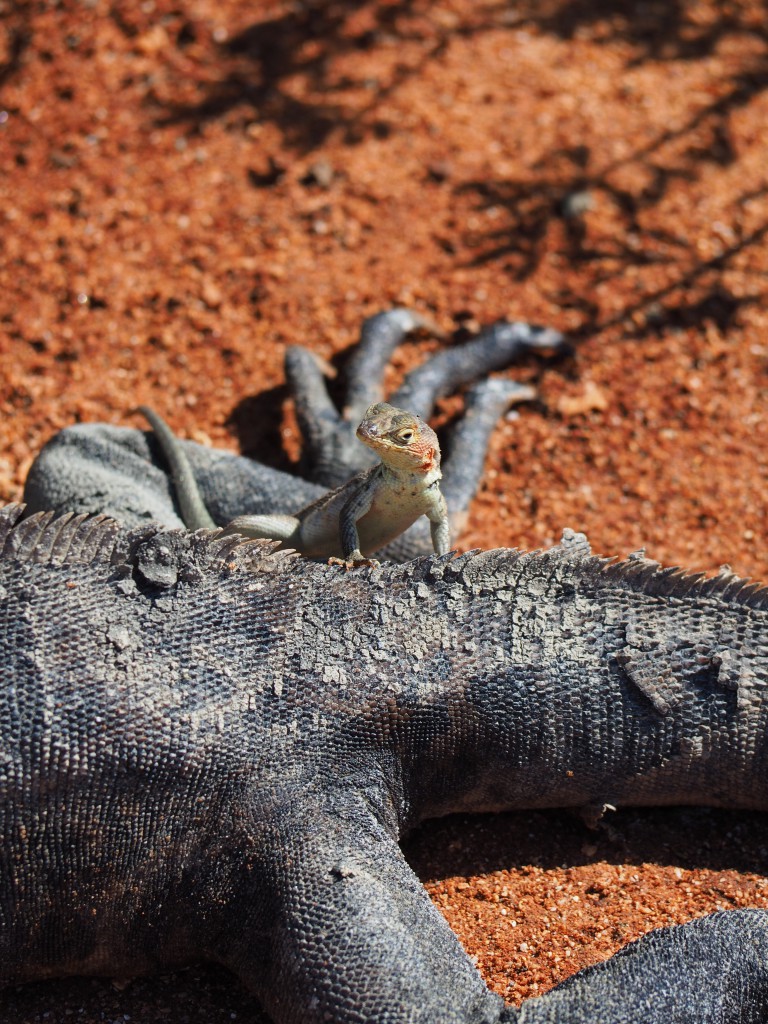
A lava lizard perching on a marine iguana – this happened much more than you’d think
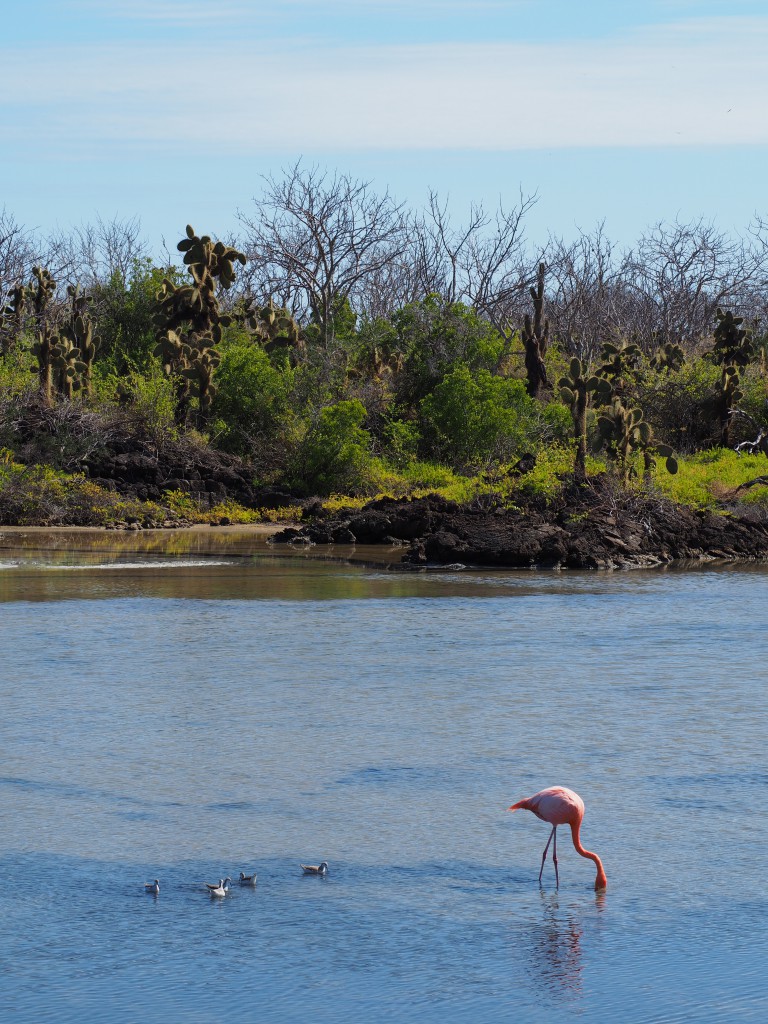
A chance to see more flamingos at Dragon Hill
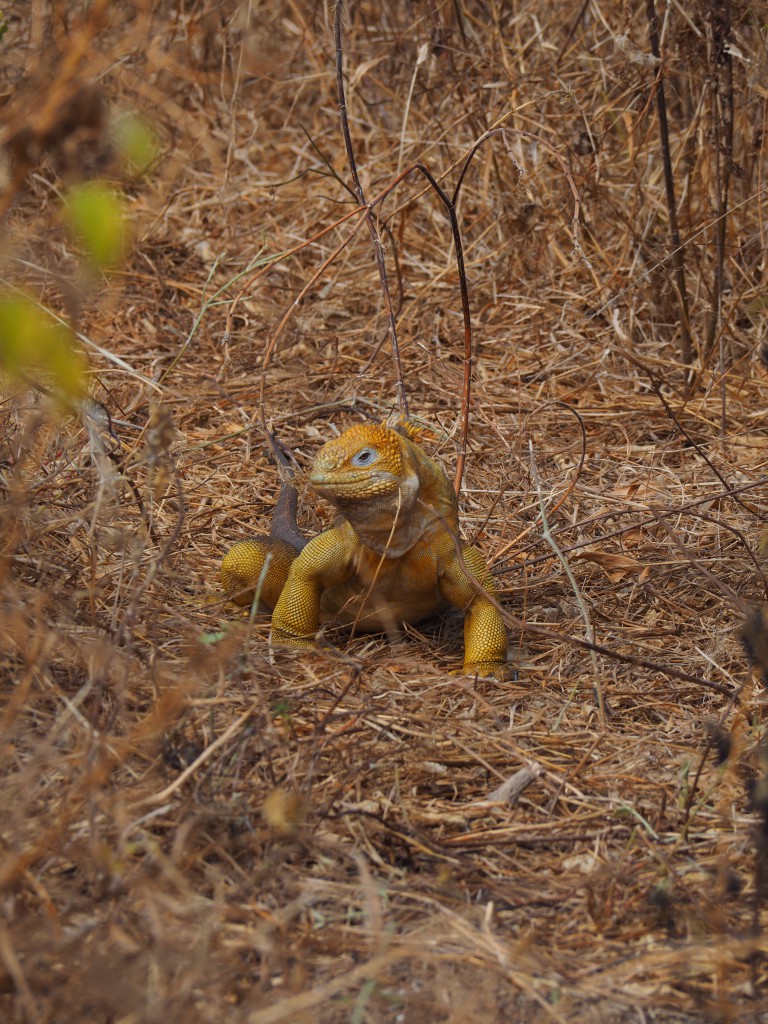
A very colourful land iguana at Dragon Hill
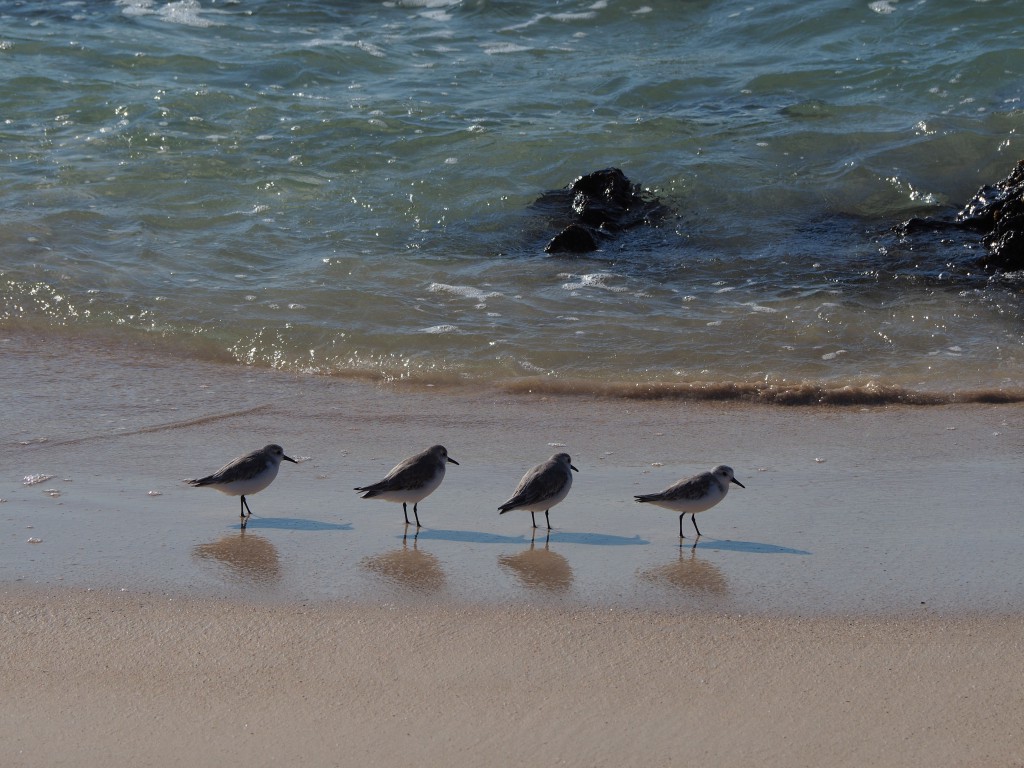
Bird quartet
By the morning, the boat was at Floreana Island, where we alighted at Post Office Bay. In the 18th Century, Whalers & buccaneers used to put mail in a wooden barrel on the beach front as an unofficial mailbox – the tradition continues today but with tourists! We found a couple of postcards we will hand deliver (you can’t cheat and just post them at home), and we left a couple of our own. We’re really interested to see when (and if!) they get delivered!
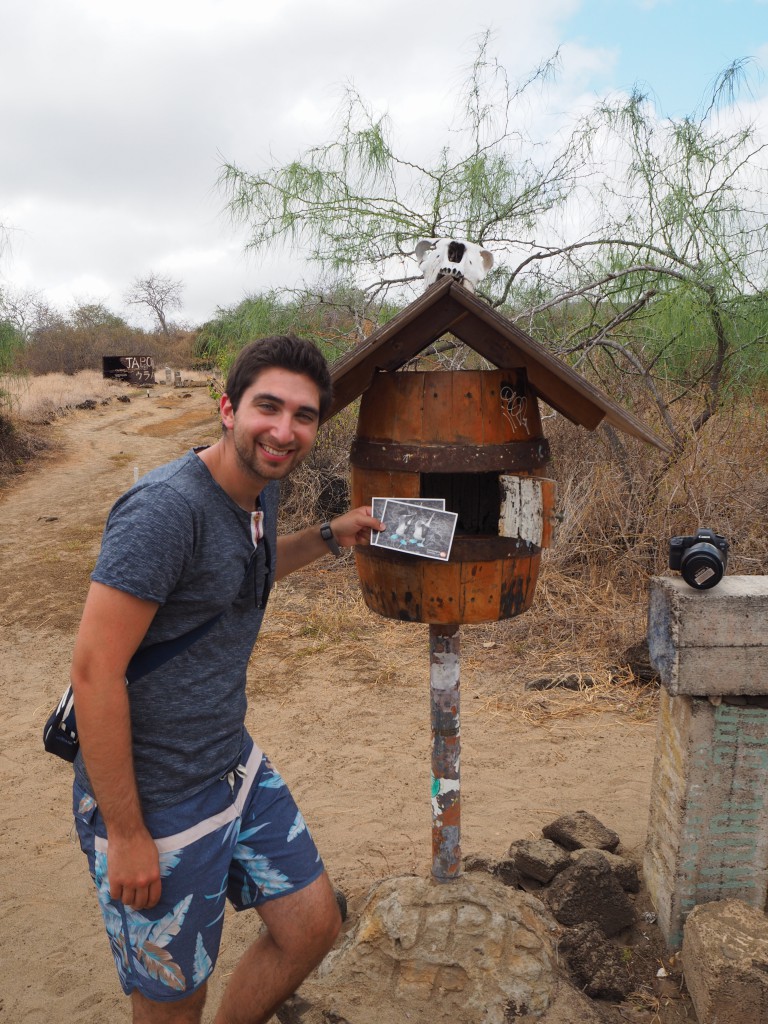
Dropping off postcards at Post Office Bay – we hope they get home okay!
We also went snorkelling at Post Office Bay, where we saw turtles, sea lions, rays and a spotted sea snake as we were getting out. A sea lion pup joined us as we were getting out of the water and seemed in a really playful mood, wondering why we were leaving. So sure enough we got back in, and sat with it for ages as it was being inquisitive – swimming around us and posing for pictures.
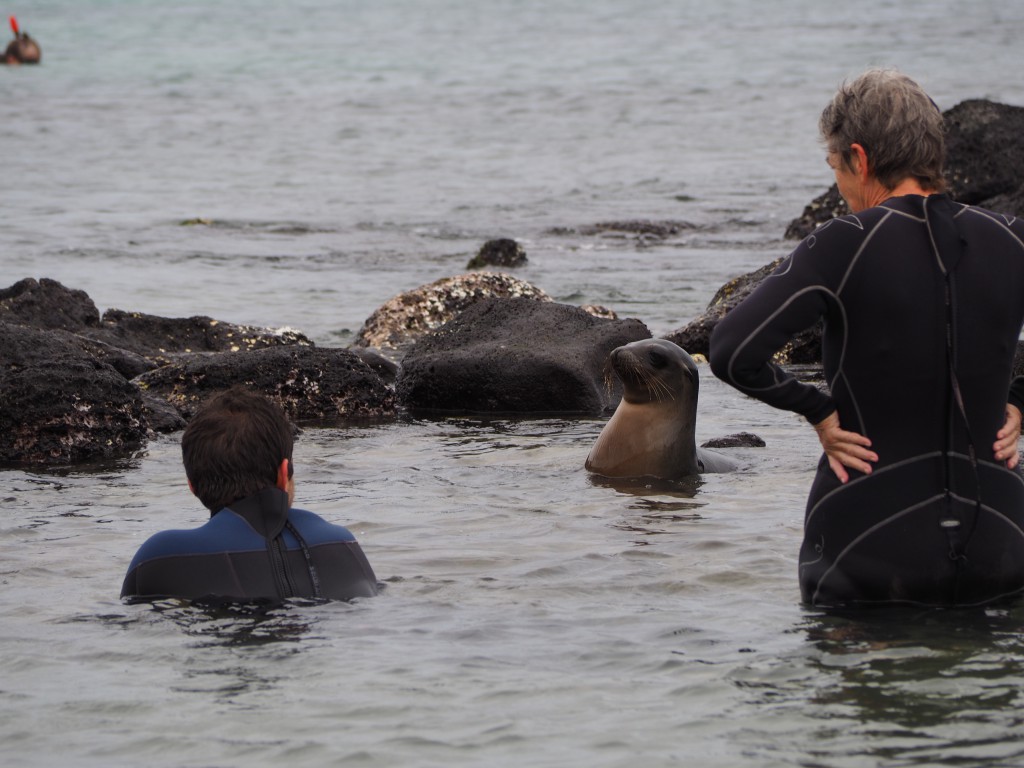
A playful sea lion pup stole all the attention when we were supposed to be leaving the bay
We then headed to Devil’s crown which is supposed to be one of the best snorkelling sites in the Galapagos (and one of the reasons why this cruise itinerary was great!). It was a deep-water snorkel for the first time, and the currents were pretty strong, but completely manageable. We saw all sorts, from a couple more inquisitive sea lions, star fish on the rocks, a white tip shark and a whole host of different types of fish, including parrot fish, long flute fish and massive shoals of more common but equally spectacular fish. We ended the day going to Cormorant Point (which actually doesn’t have any cormorants…) where we saw more flamingos, and some blue footed boobies up close, and then the other side at a nearby beach, we also saw a lot of rays coming up close to the shore, and a few fishing penguins.
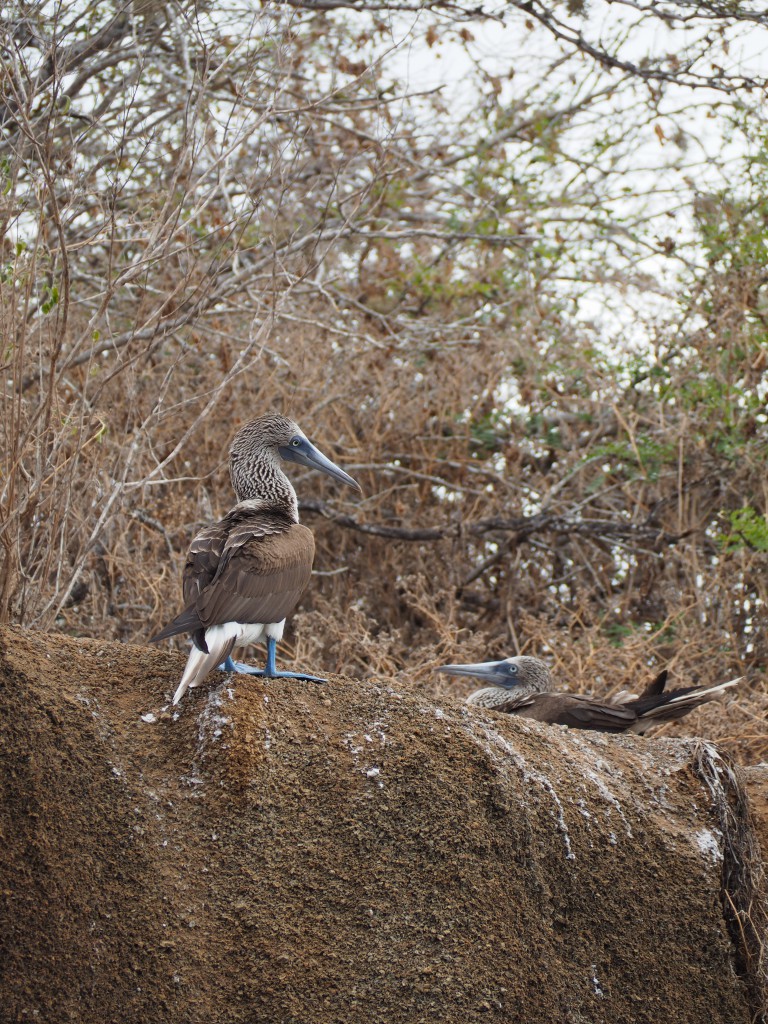
Magnificent blue-footed boobies
Next up, Espanola Island – described as the “jewel in the crown of the Galapagos” (and another reason why we picked this itinerary). We alighted at Suarez Point, and in terms of the amount of animals we saw, it was incredible. At one point we were blocked from our path by hundreds of marine iguanas!
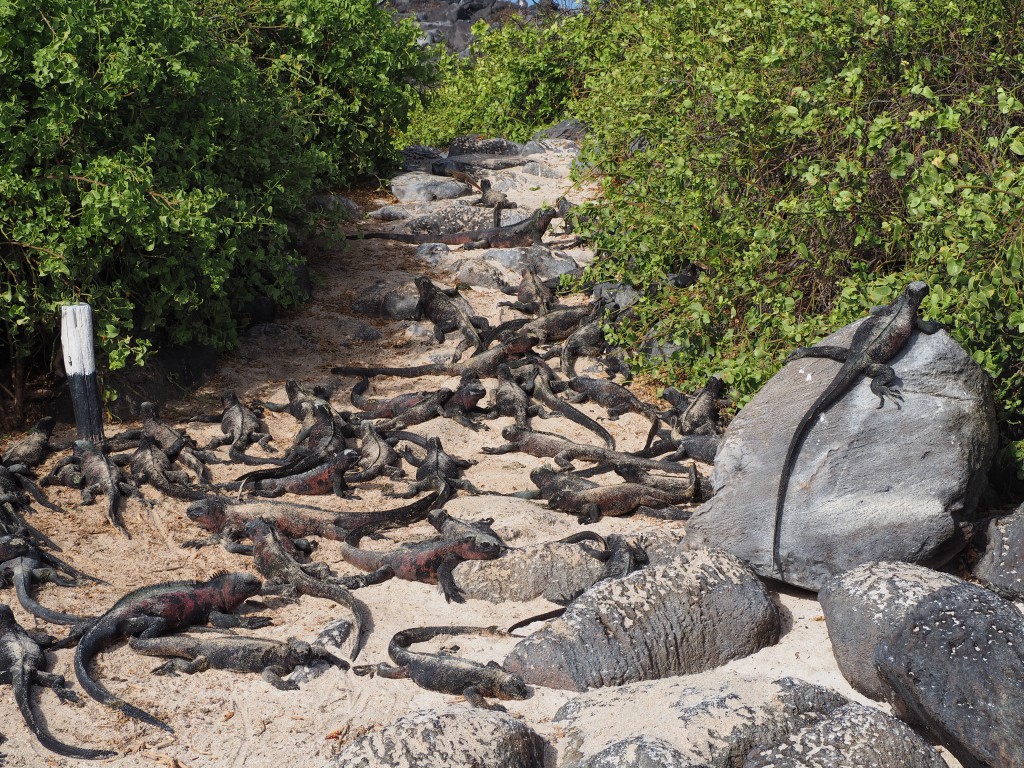
Marine iguanas blocking our path so we had to take an alternative route
We also saw loads of hermit crabs (I loved these!! They were so fun!) and the tail and blowhole spray of a humpback whale in the distance. We saw loads of birds, including blue footed boobies, frigate birds, nazca boobies, and the magnificent large-waved albatross, which were nearly always hanging out in couples which was pretty sweet. We also saw a baby albatross that looked and walked like a turkey (fluffy with no proper wings!), and on the way back to the boat someone noticed a hawk chick which had adorable drumstick legs!
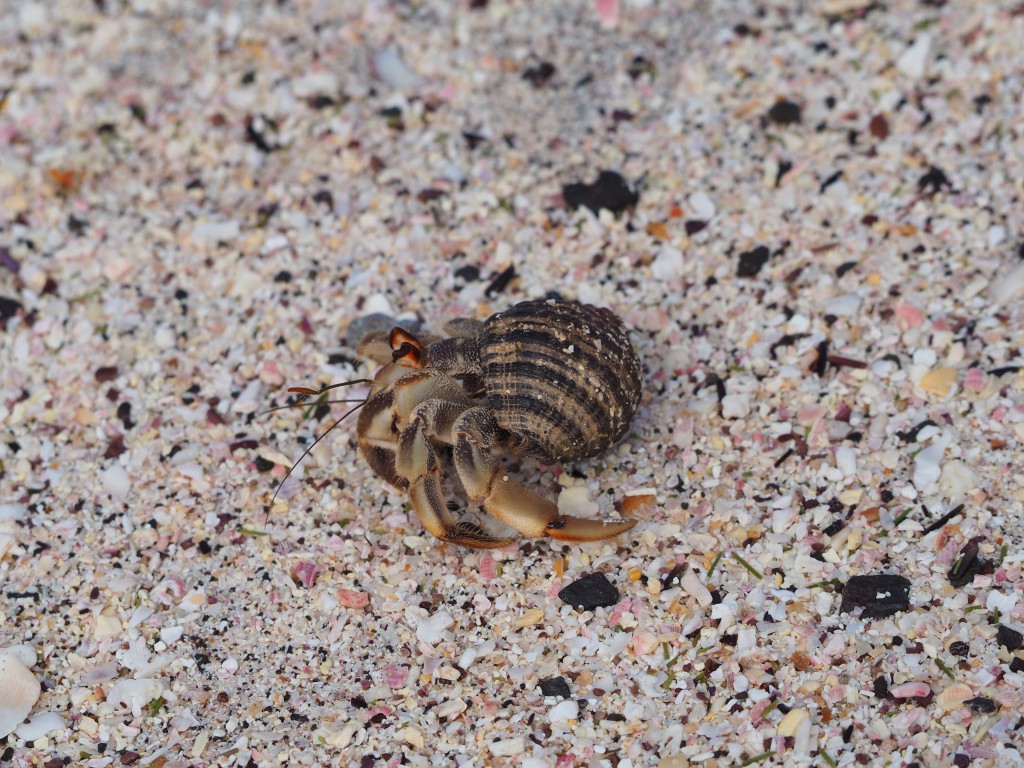
Hermit crabs everywhere! Look how big and cute their eyes are!
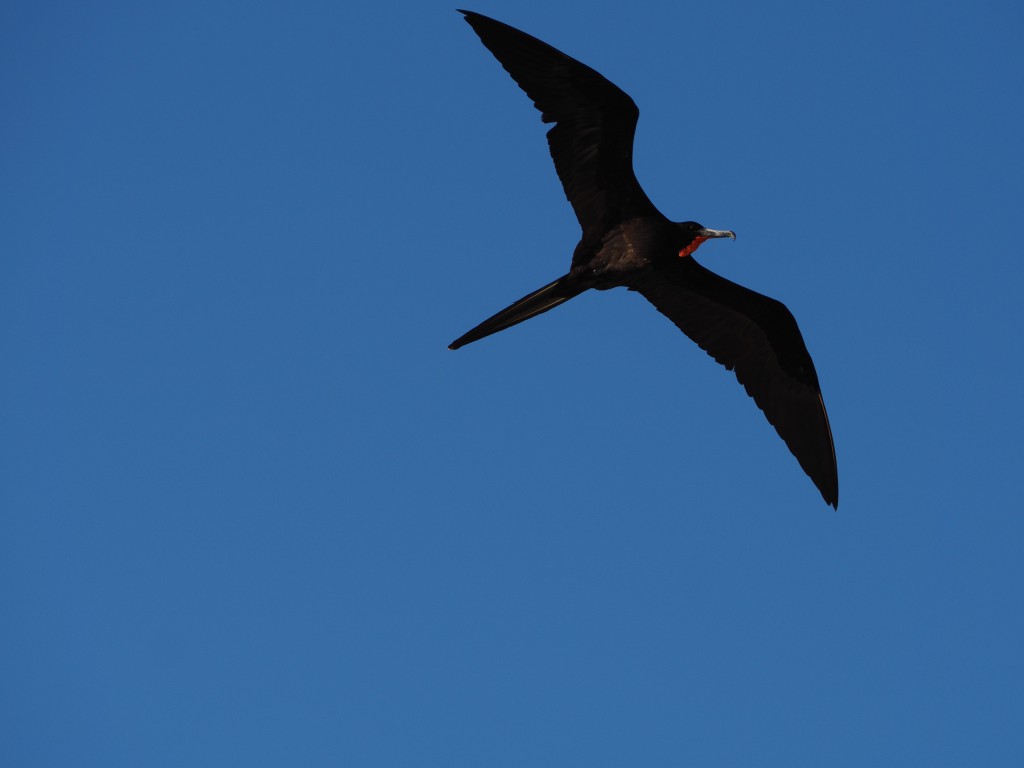
A frigate bird flies overhead
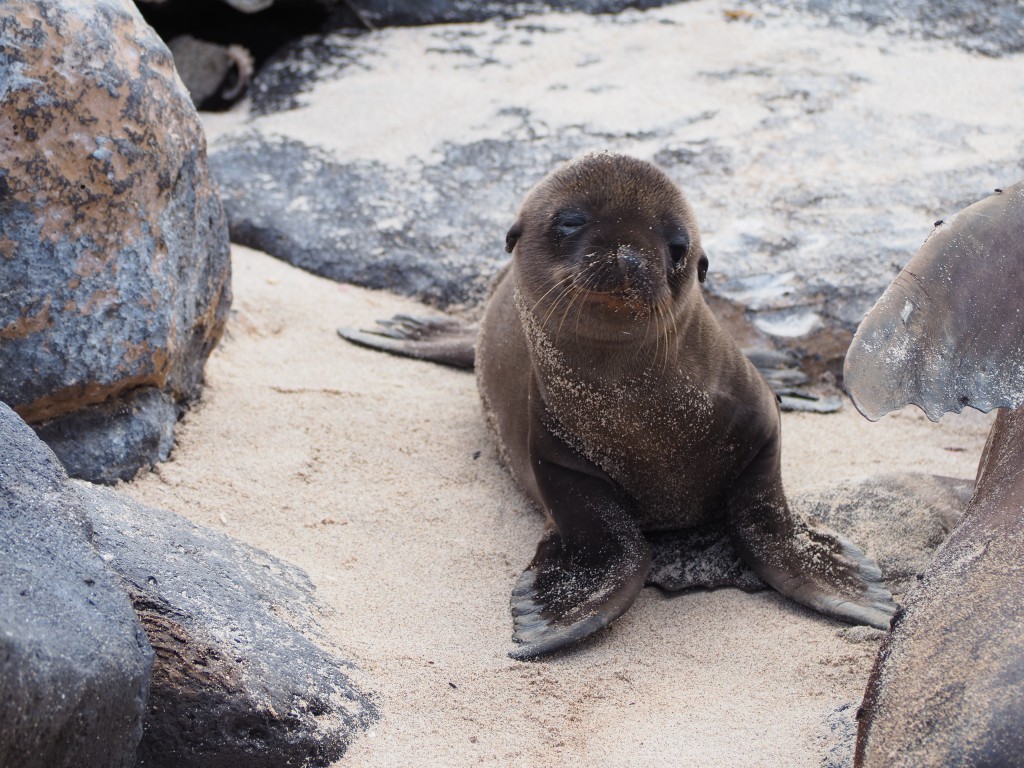
A seal pup taking a few seconds break from feeding from its mother
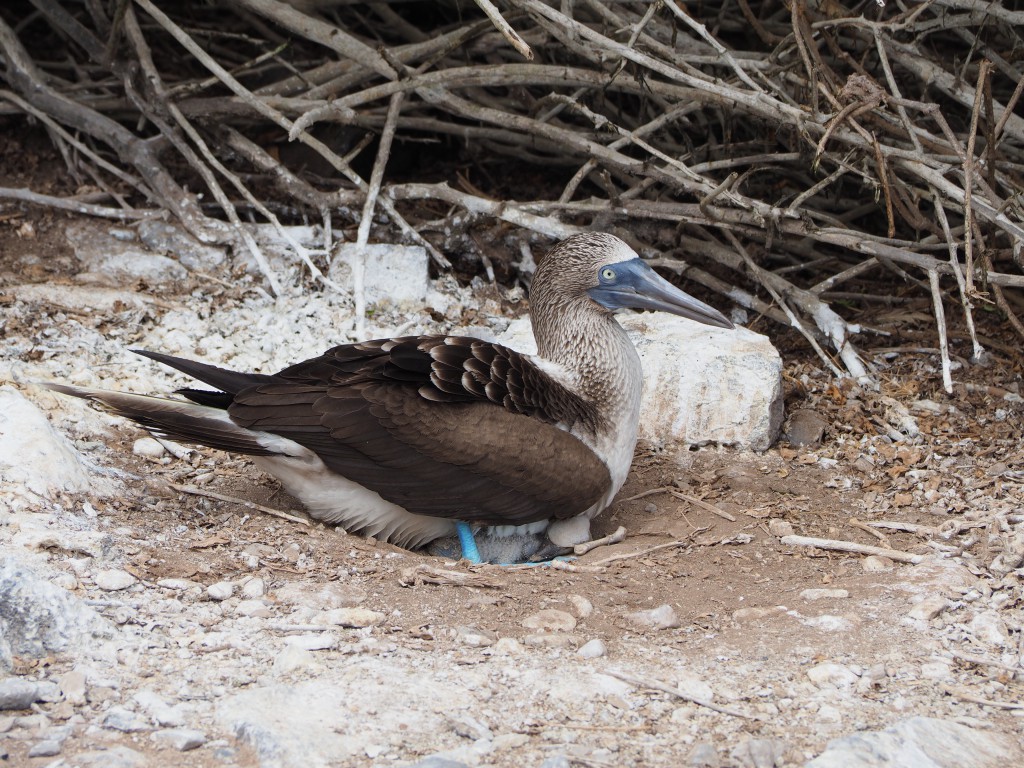
Blue footed boobie nesting a chick underneath
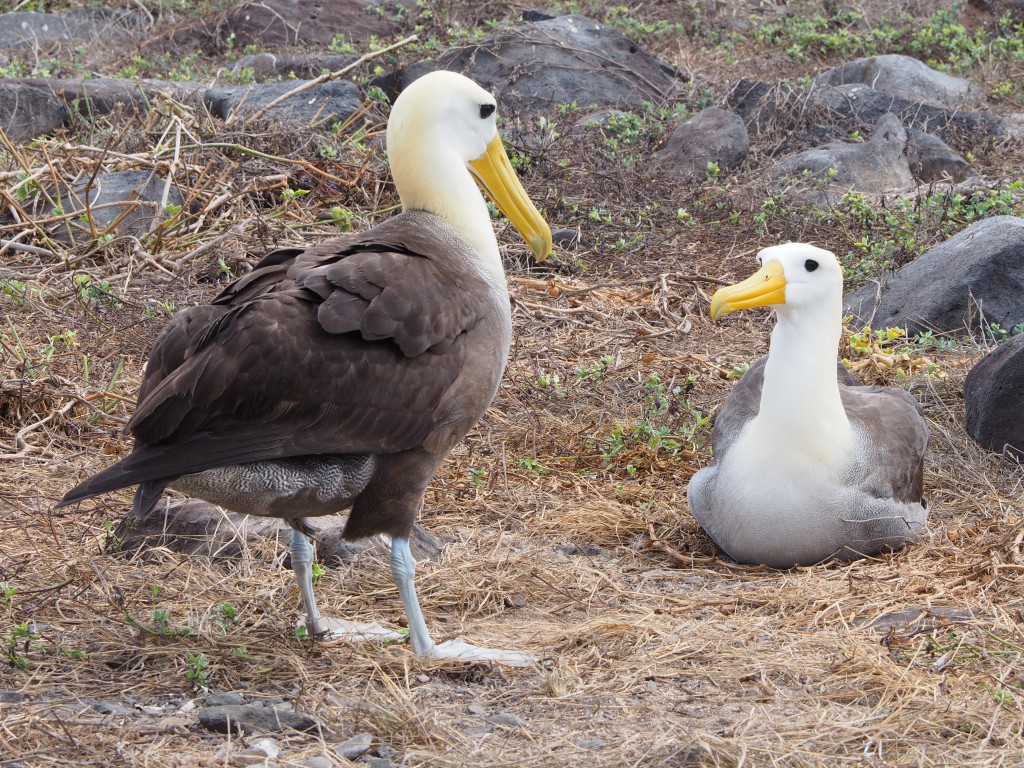
A large-waved albatross couple on Espanola island
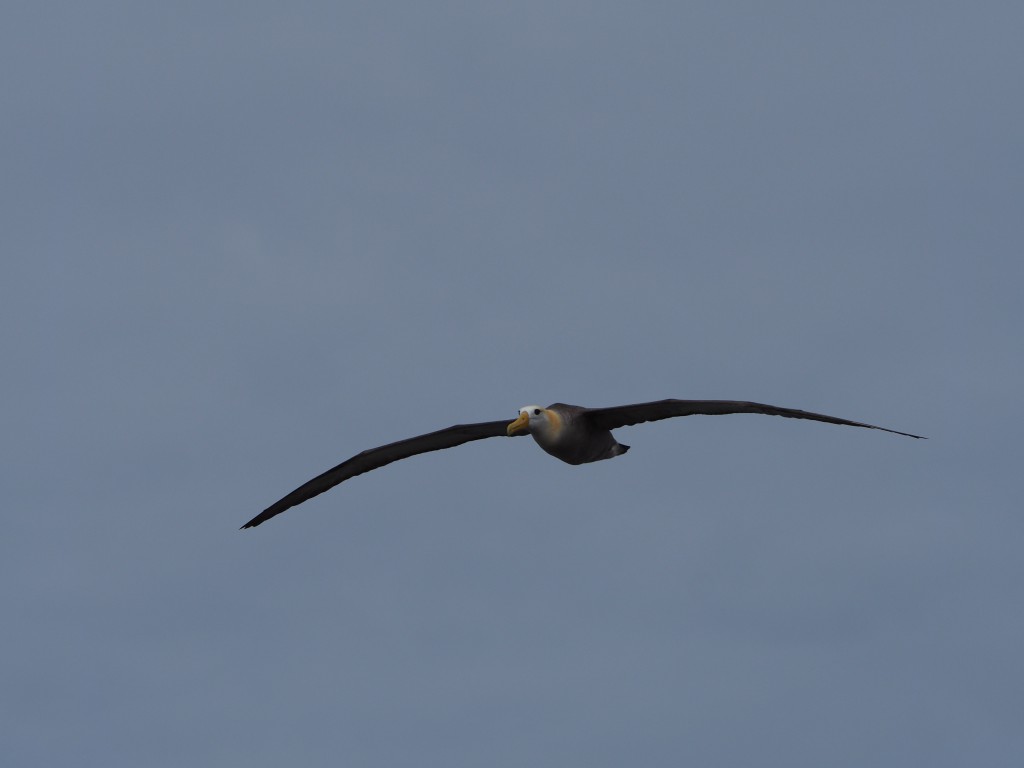
Albatross in flight with its huge wingspan
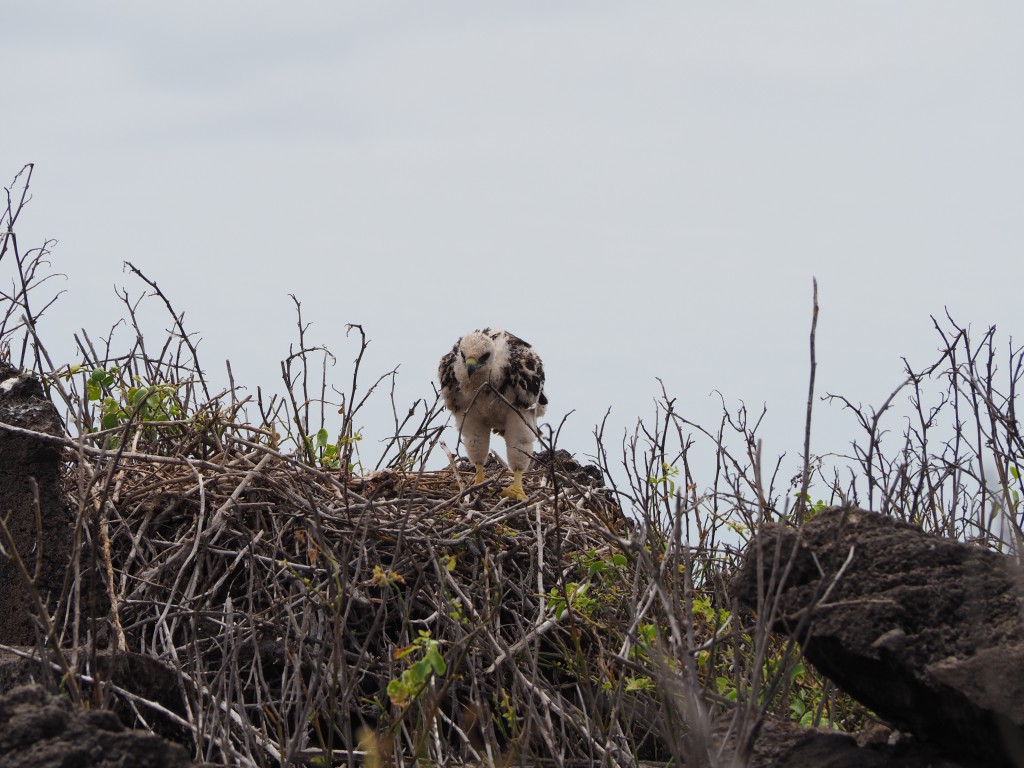
Baby hawk calling out for its mum – look at the cute drumstick legs!
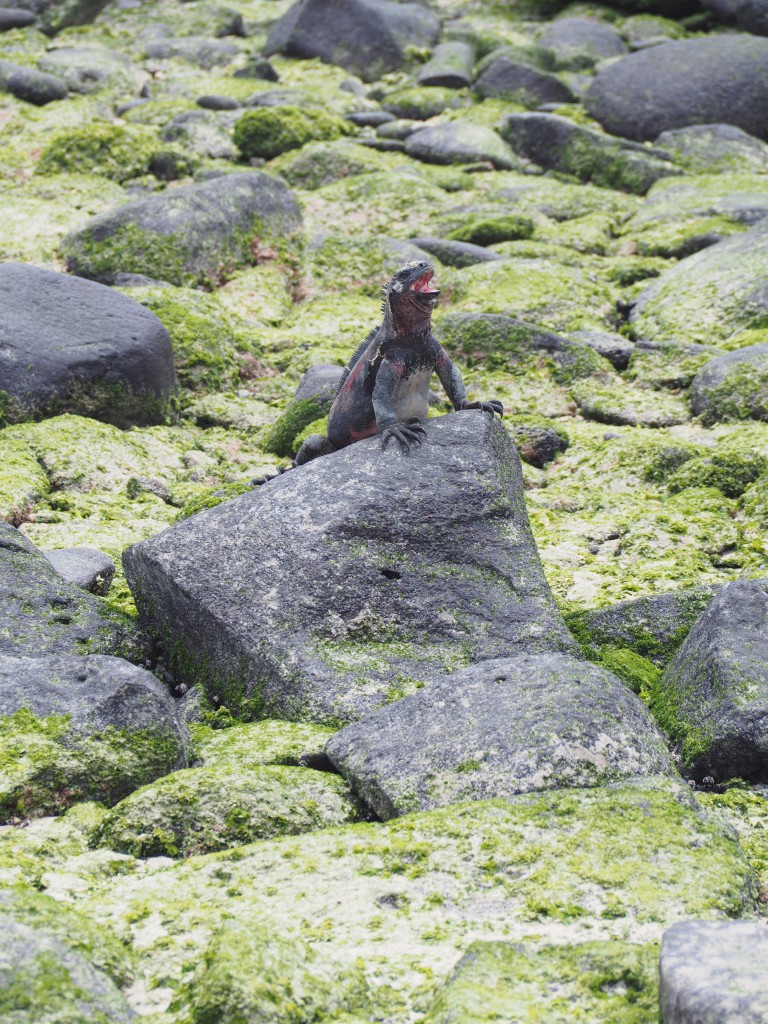
A marine iguana yawning
In the afternoon we went to Gardener Bay, which is famous for its sea lion colony. We thought we’d seen a lot up to this point, but there were so many lying on the beach when we arrived! Also, there were a hell of a lot of flies, which were really annoying (but what can you expect on a beach full of smelly sea lions?). We went for our last snorkel of the trip here and among other things we saw a white tip shark dwelling in a cave below our feet. We then cruised towards Puerto Baquerizo Moreno on San Cristobal island, where the cruise was ending. In the evening, we had our last dinner and goodbye cocktail on-board the boat.
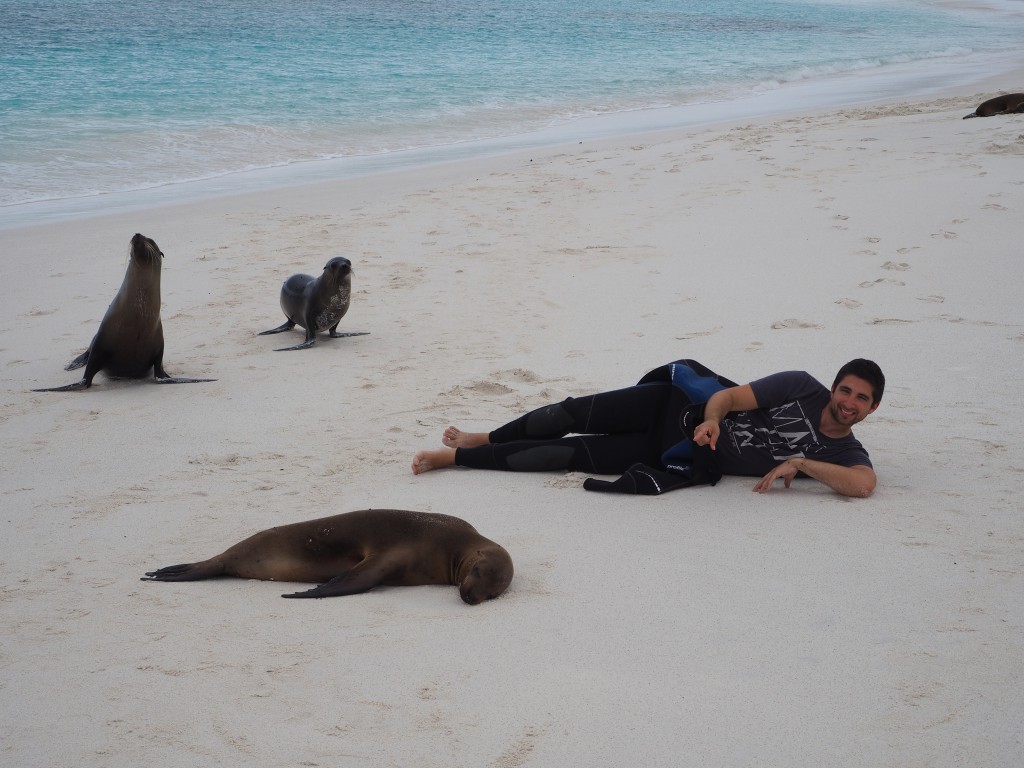
Chilling out with the sea lions on Gardener Bay, moments before that pup in the background runs up to me and scares the life out of me
On our final day of our cruise (morning), we visited the Galapagos Interpretation Center which is the best place on the Galapagos to learn about the history of the Galapagos and future conservation efforts – it was certainly worth a visit. Then, we said goodbye to our fellow passengers from our cruise. We were pleased to still have a further three days to enjoy San Cristobal island, on the last of the inhabited towns that we had not yet explored.
That afternoon we ended up spending most of our time on Playa Mann beach – we were not initially planning to go there but we got distracted by all the sea lions on the beach as we were walking past. This is the first time we saw a colony of sea lions in the mix with humans – the water and the beach were being shared by human families and families of sea lions at the same time!
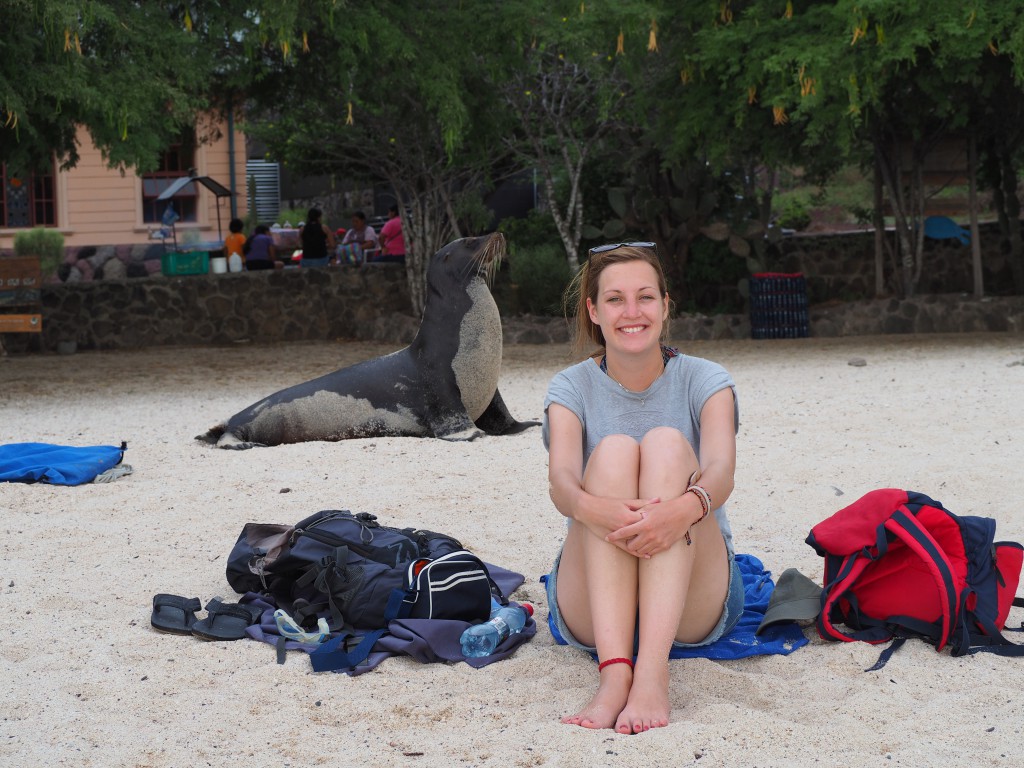
Chilling out on Playa Mann, when the sea lions weren’t stealing our chill-out spots
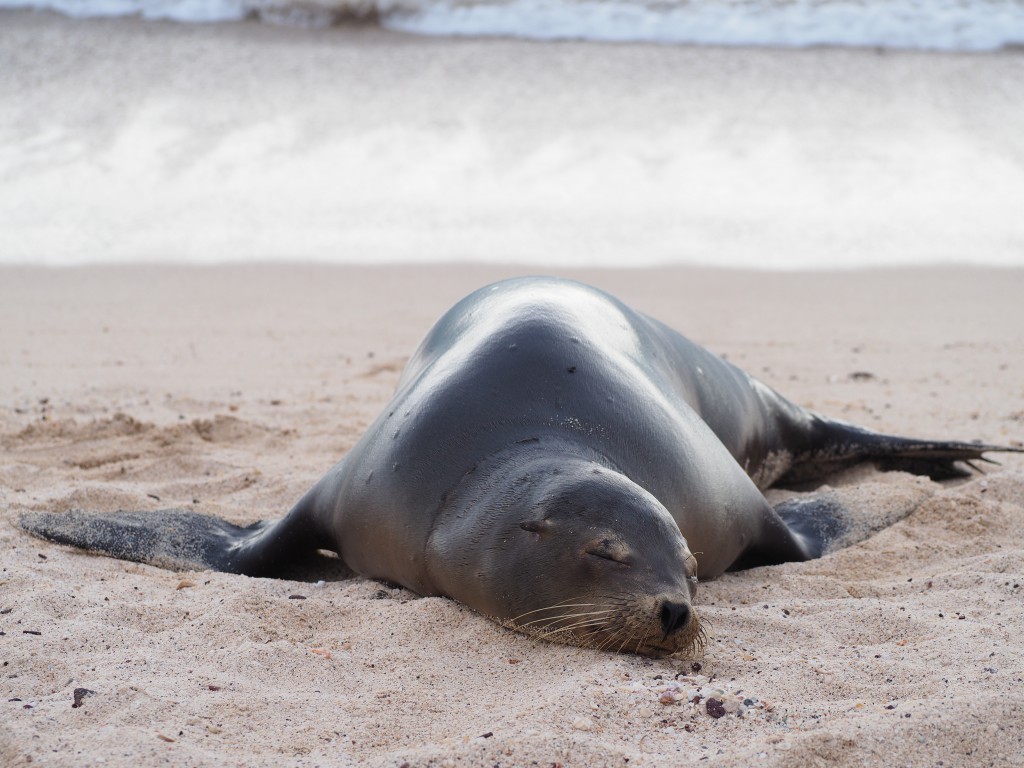
Sleepy sea lion at Playa Mann
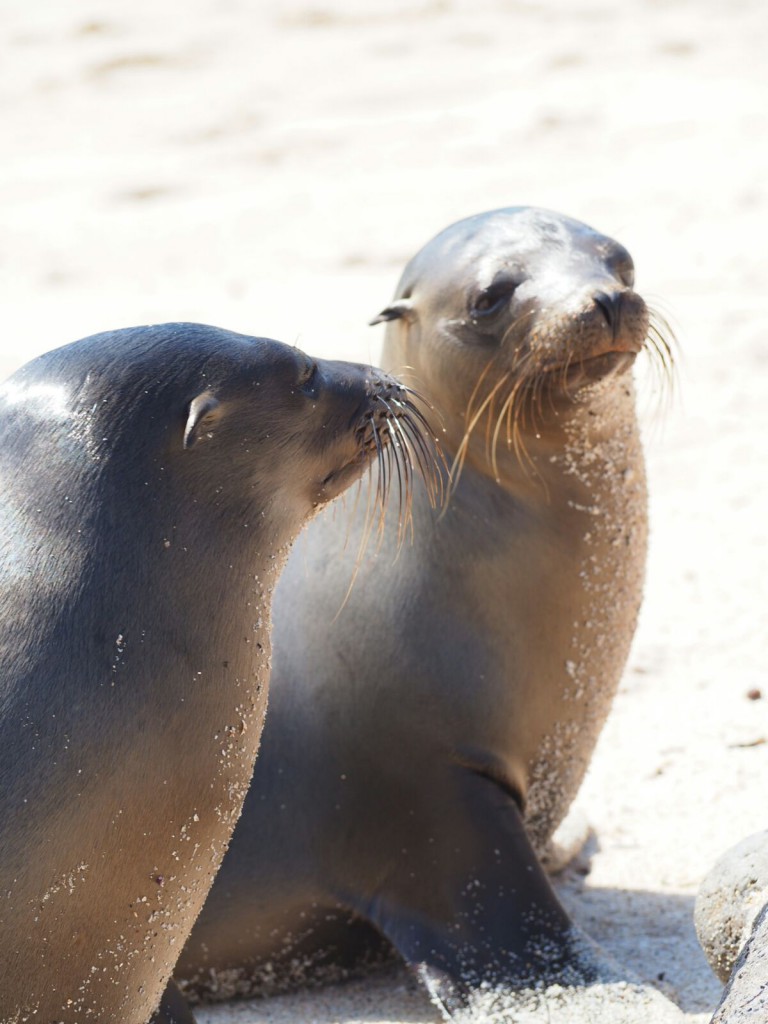
More sea lions up close at Playa Mann
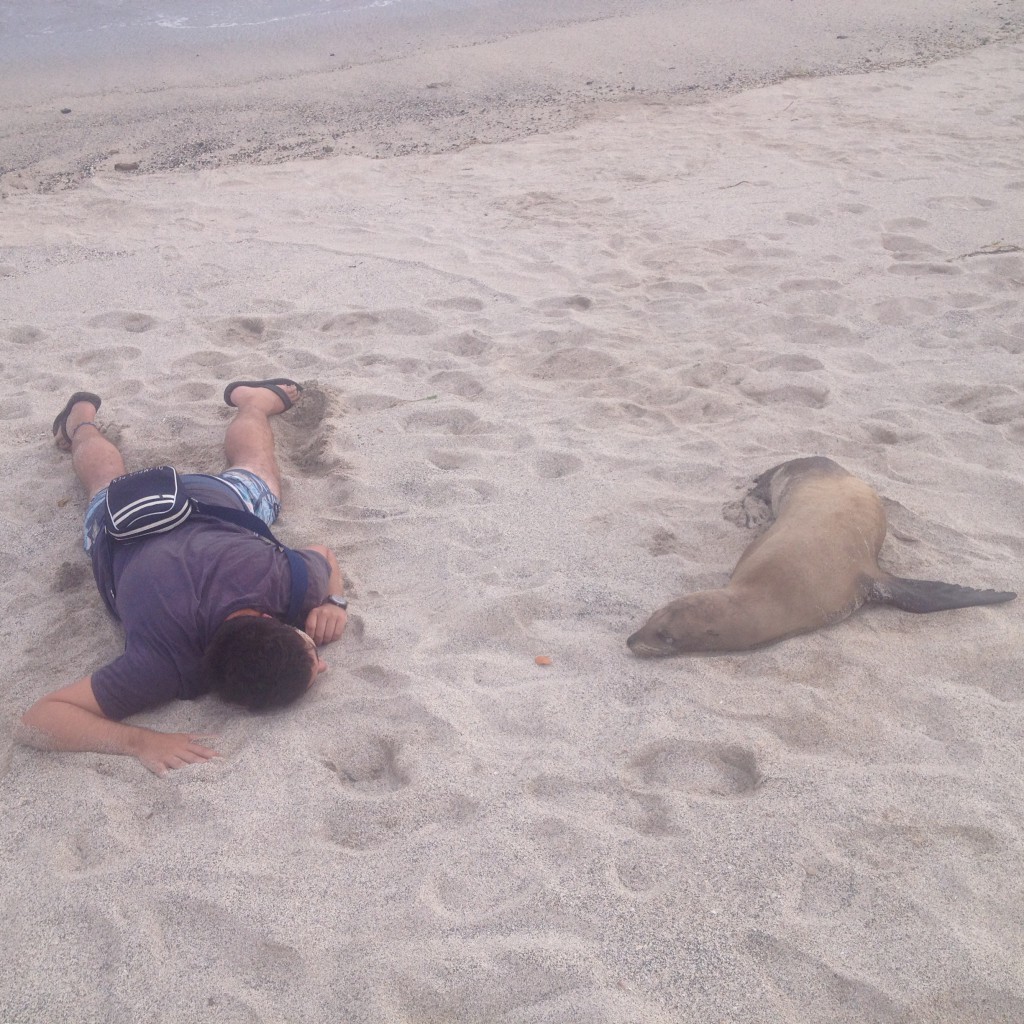
Imitating a particularly sociable sea lion at La Loberia
On San Cristobal we also explored the walking trails around the Galapagos Interpretation Center and came across frigate birds nesting at Cerro Tijeretas (literally translates as frigate bird hill) and more iguanas and hermit crabs at Playa Punta Carola. La Loberia was another beach which we had heard good things about but it was a bit of a let down in terms of things to see and the waves were too rough to swim in the water. However, I did get to hang out with another playful sea lion, where I think he enjoyed me imitating him (Hat laughed as I rolled around in the sand). We also saw a humongous millepede on the walk back which was probably longer than my foot, which was pretty creepy.
The only day trip we booked on to on San Cristobal – snorkelling at Kicker Rock – turned out to be one of the highlights of San Cristobal (and probably the Galapagos as a whole). Along with Devil’s Crown, this is known as one of the best snorkel (and dive) spots on the islands and one of the best places to see hammerhead sharks. Although unfortunately we didn’t see any of these, we swam with three other types of shark- white and black tip reef sharks and the Galapagos shark. They were happily wading through the biggest shoals of fish we had seen thus far, and happily for us not nibbling our legs. We also enjoyed seeing a gang of pufferfish, and on the way back to the mainland on our boat, we saw some puffed-up frigate birds for the first time (they do this to impress their desired mate)!
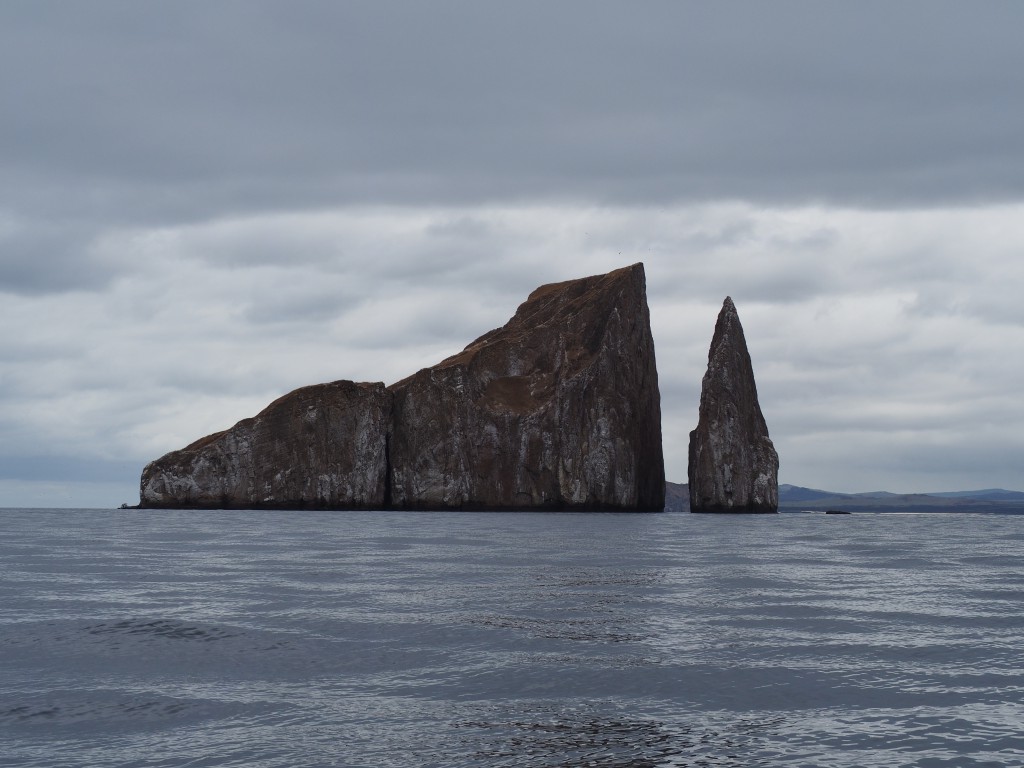
Kicker Rock
A final highlight of San Cristobal was seeing the night heron in town. He was there every night when we went out for dinner, seemingly patrolling the streets.
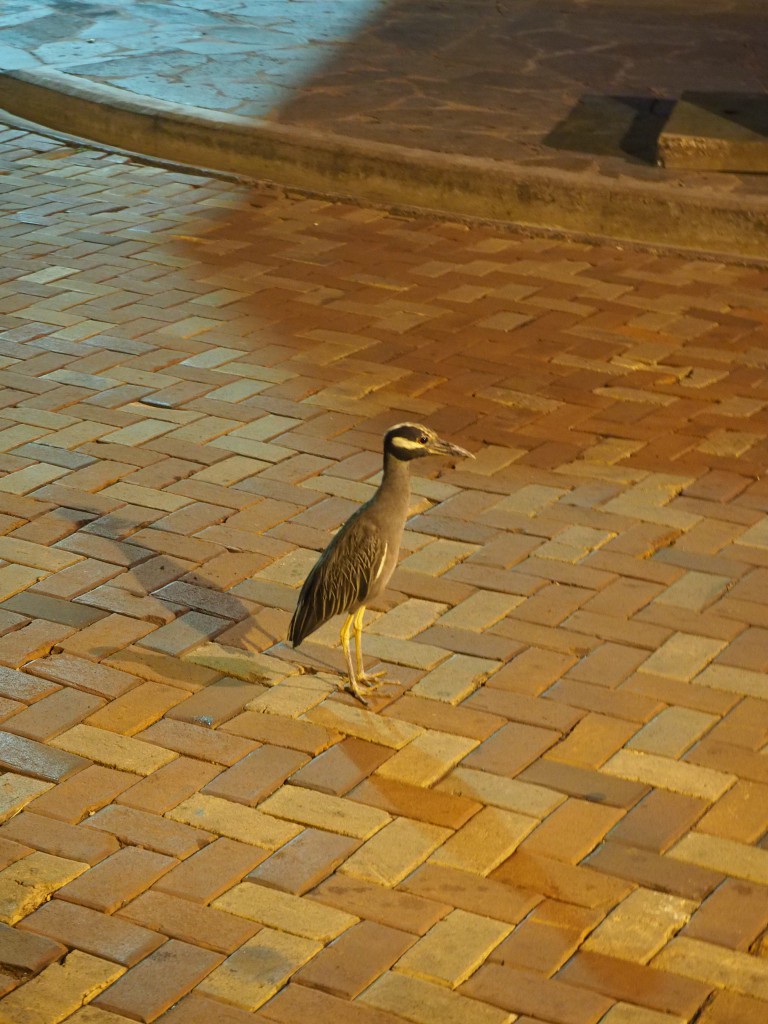
The night heron patrolling the streets of Puerto Baquerizo Moreno on San Cristobal
We absolutely loved the Galapagos and it was certainly a highlight of our whole trip – it felt like a mini holiday within our mammoth trip and it was exactly what we needed, as we were getting pretty exhausted with travelling. The amount of wildlife living on the islands is something else – Galapagos classics like blue footed boobies, giant tortoises, lava lizards, marine and land iguanas, finches and unbelievable numbers of sea lions (everywhere – on benches, lounging across boats and waddling across peoples beach towels on the beach). Also we were surprised to see penguins and flamingos up close in such a bio-diverse place!
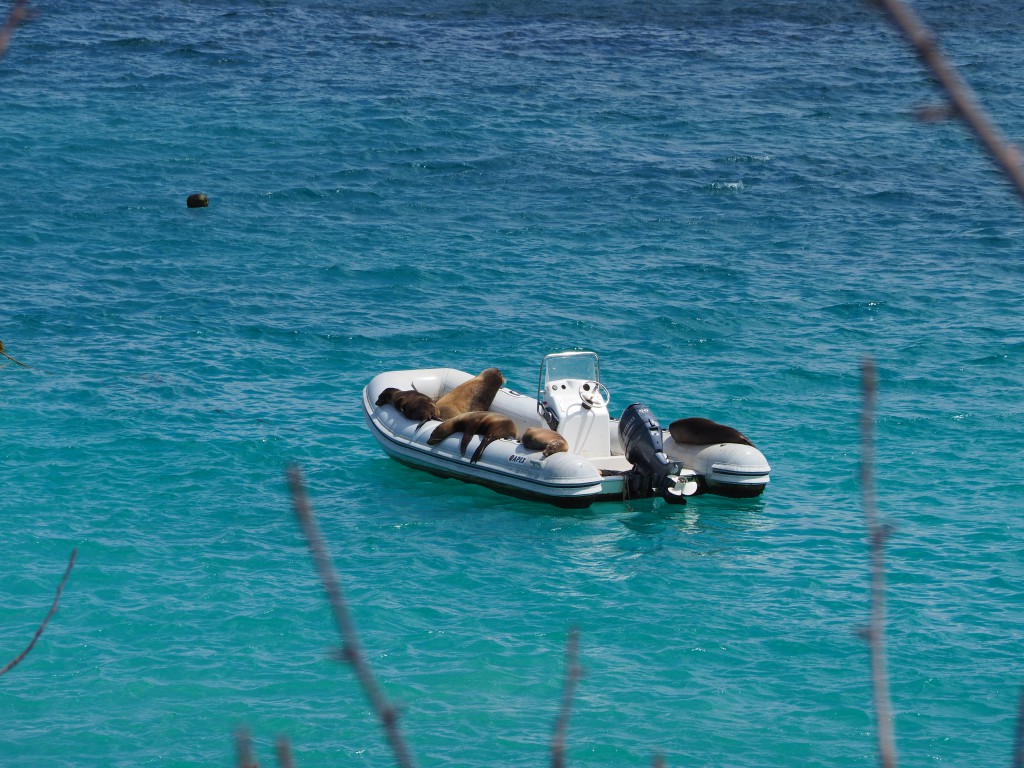
Sea lions took advantage of anything they could have a sleep on, including this speedboat
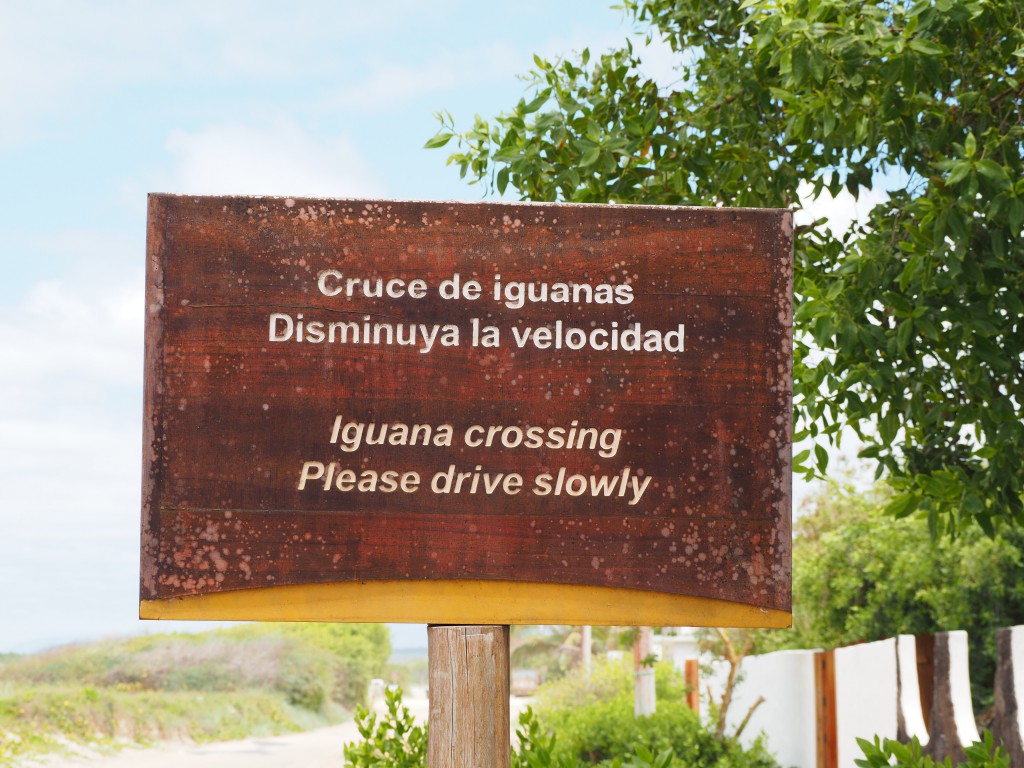
Signs like this only exist in the Galapagos…
As well as enjoying the Galapagos scenery and wildlife we also met an excellent bunch of people on our cruise – mostly wildlife enthusiasts who gave us some excellent tips on other places in the world where we can see some amazing wildlife – now we are full of ideas for the future…
We flew back to Quito, Ecuador to get back in to the swing of travelling for our final 4 week home-straight through North Ecuador and Colombia, but we really hope one day to return to the magical Galapagos Islands!
——–
Tips on how best to do the Galapagos:
- You can see about 70% of the wildlife without a cruise. Yep, it’s true! We saw a hell of a lot from just exploring the islands and doing two day tours, although maybe not in the quantity or diversity we saw on the further afield islands. Check which islands you’re interested in, and check if they can be reached by boat in a day from an inhabited port, as this will be much cheaper.
- If you decide to go for a cruise spend at least a few days either side of it exploring the islands for yourself in either free activities or day tours.
- Don’t book day tours in advance of arriving on the islands. The day tours we booked were only about $100, compared to $225 quoted by an agency before we arrived. However, in peak season, Kicker Rock can be sold out a couple of days in advance, so just bear that in mind.
- Shop around on the islands when it comes to day tours. A lot of the agencies don’t have their own boats, they just work with boat operators and freelance guides, but they will be selling the same tours. We highly recommend looking at Kicker Rock (San Cristobal island) and Los Tunneles (Isabela island) as day tours.
- If you’re looking to book a cruise and are not in peak season, you can get a cruise much cheaper if you book closer to the date you require. We booked ours online 2 weeks before and got a fair deal (2 for 1), but actually when we arrived on the islands (23rd August) the peak season had just ended and there were more bargains to be had on cruises that seemed to be better than ours. Just bear in mind you may have less flexibility on cruise itinerary if you go super last-minute.
- Research boat itineraries – some are pretty crappy as with some itineraries you can do maybe 2 days worth of activities for free or by yourself for cheaper in a day tour. If you’re interested in birds, you’ll probably want to visit Isabela and the northern islands for example too.
- Be flexible and spend as long as you can on the islands – there is lots to do, and this will give you enough time to book up day tours, maybe a last-minute cruise and enjoy the beaches and natural surroundings
- Stay in hostels or use Airbnb – it’s really quite affordable to stay on the islands if you do it this way, and the accommodation is some of the best for the price in South America. We paid about £25 per night for a comfortable double room with air conditioning.
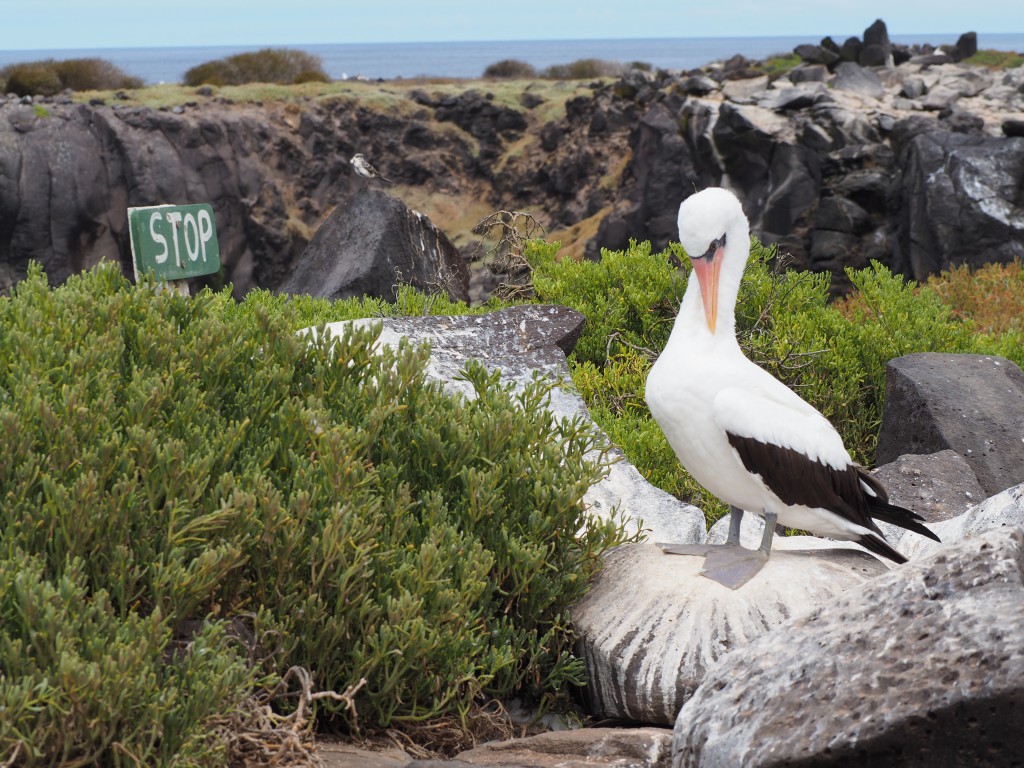
Nazca booby at a stop sign